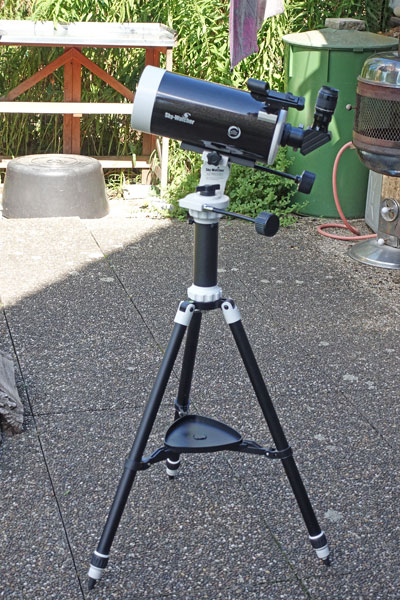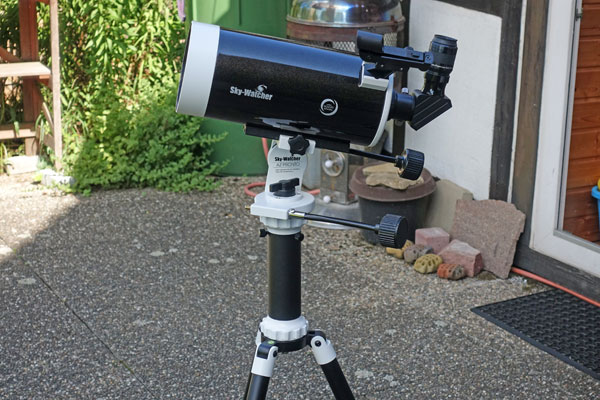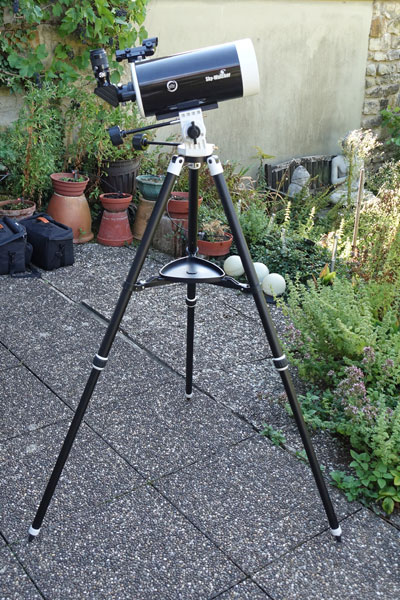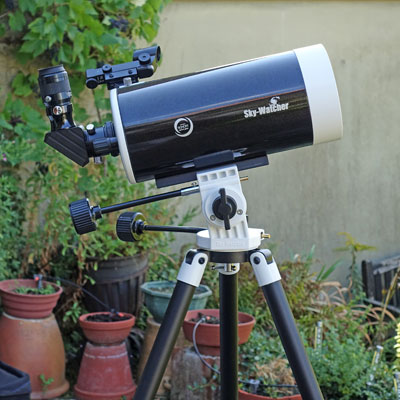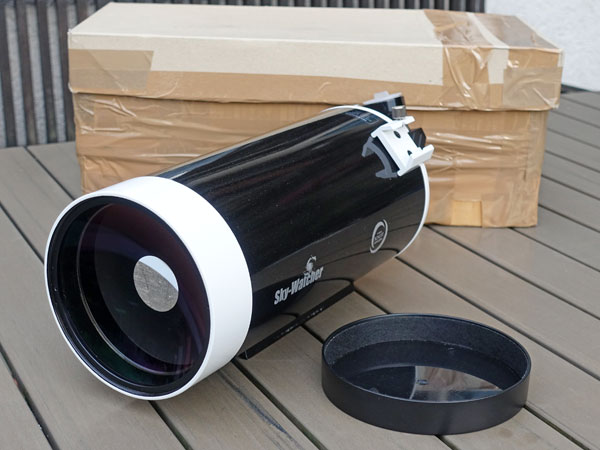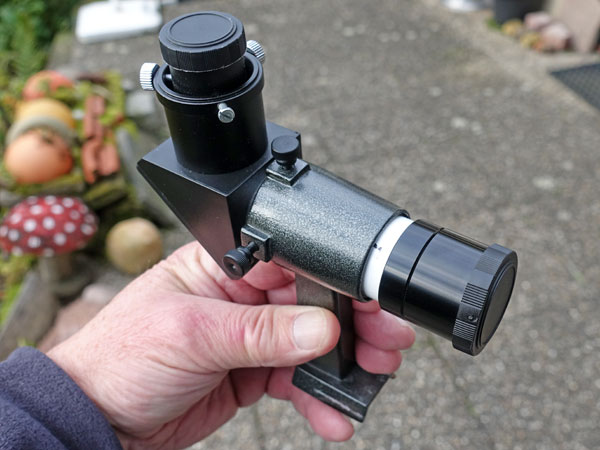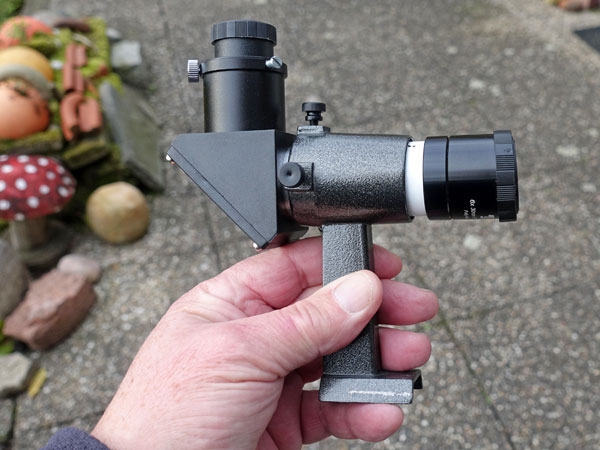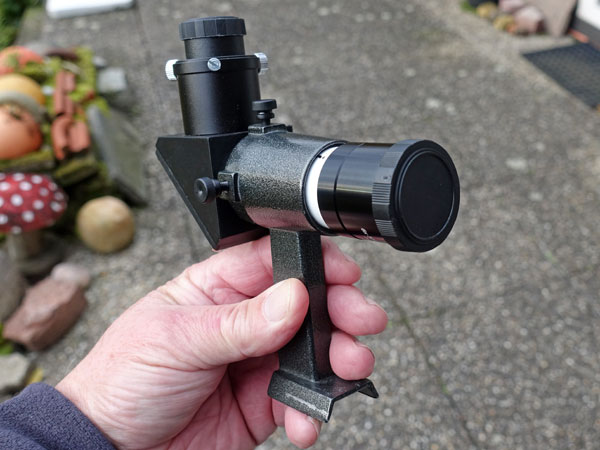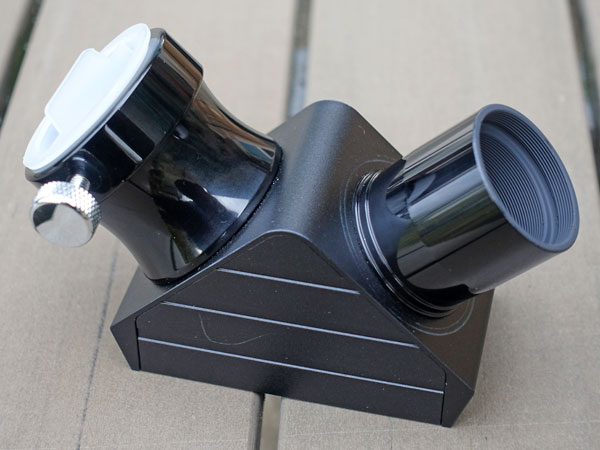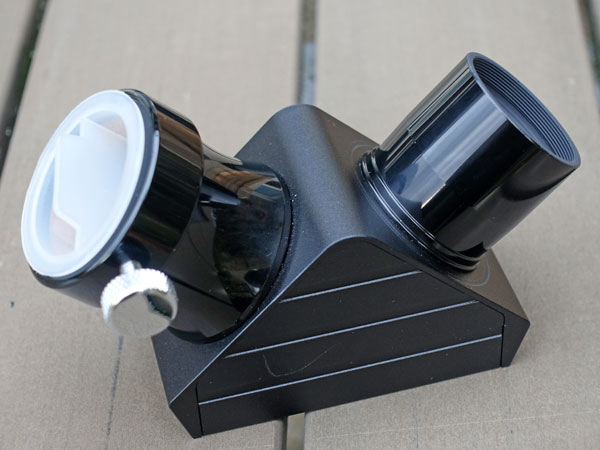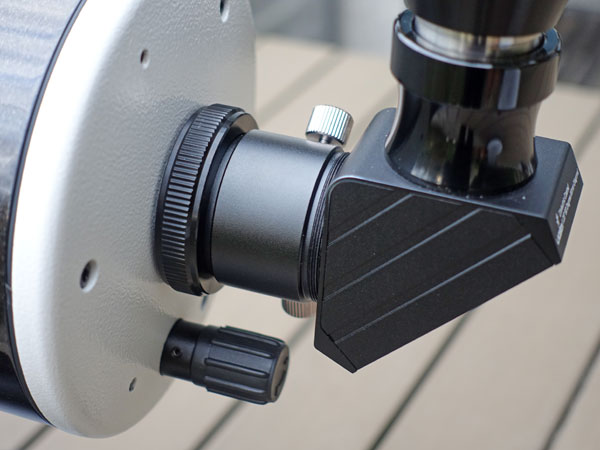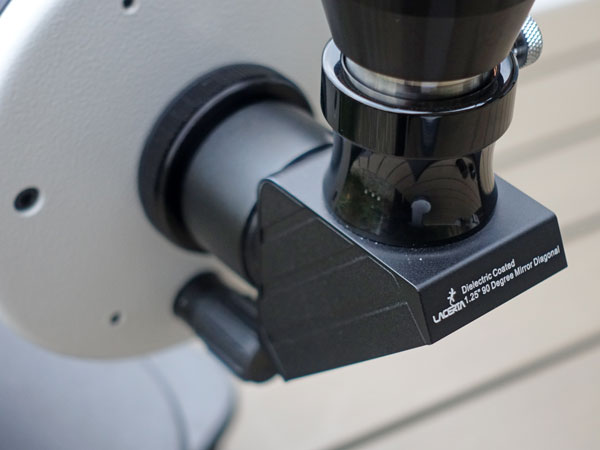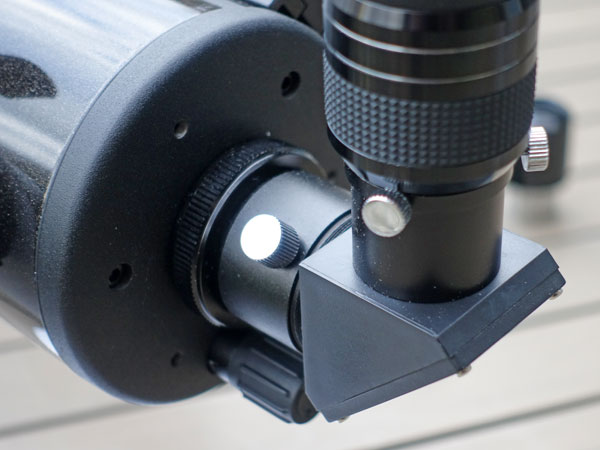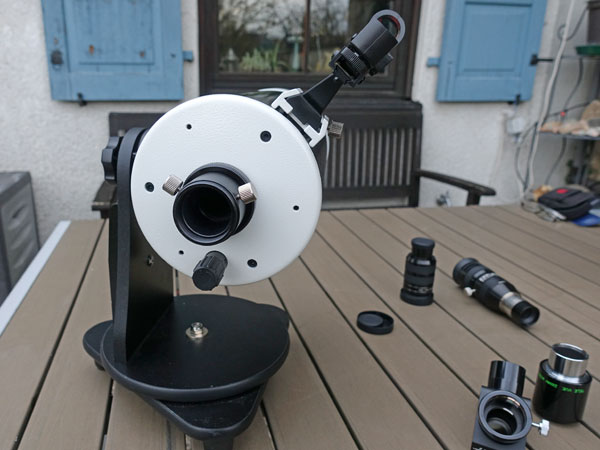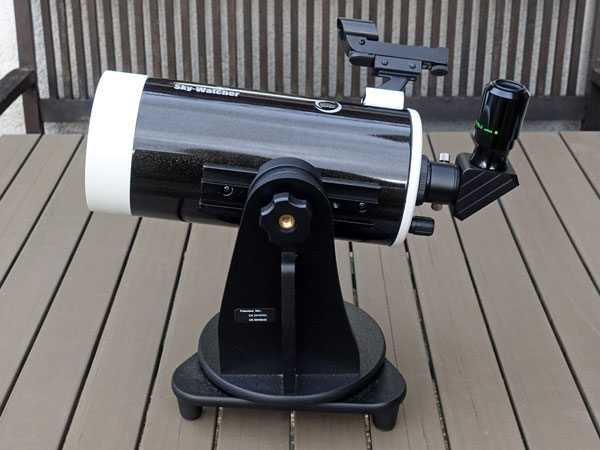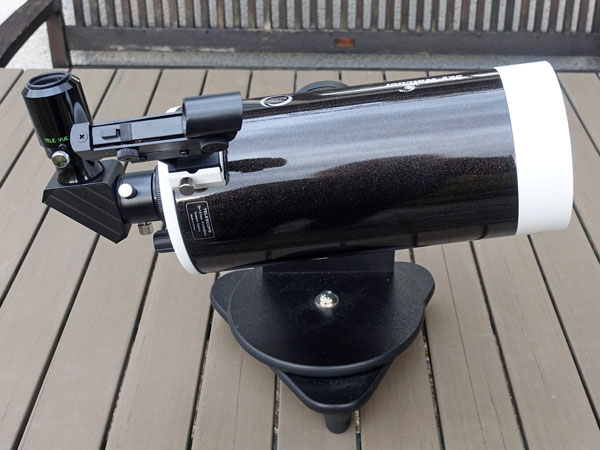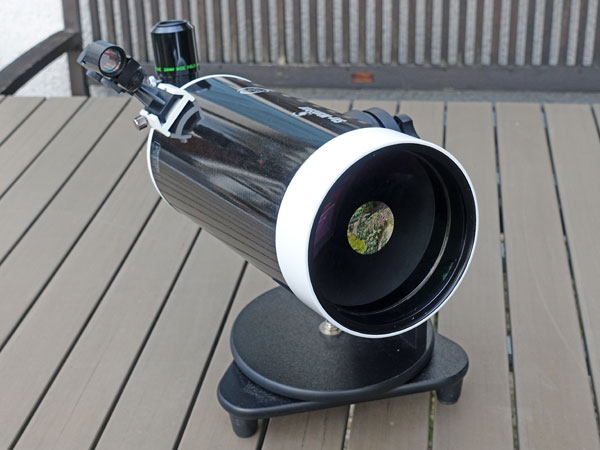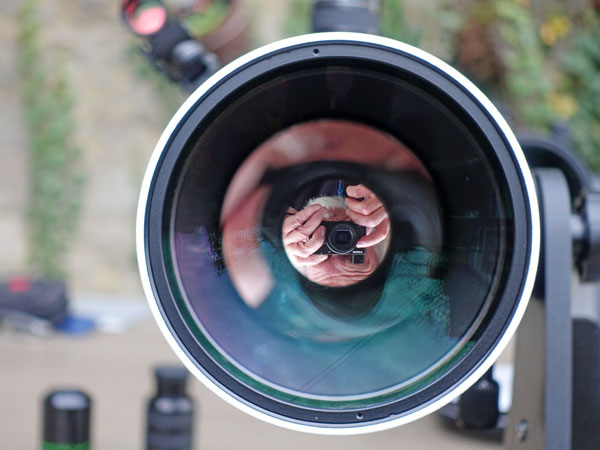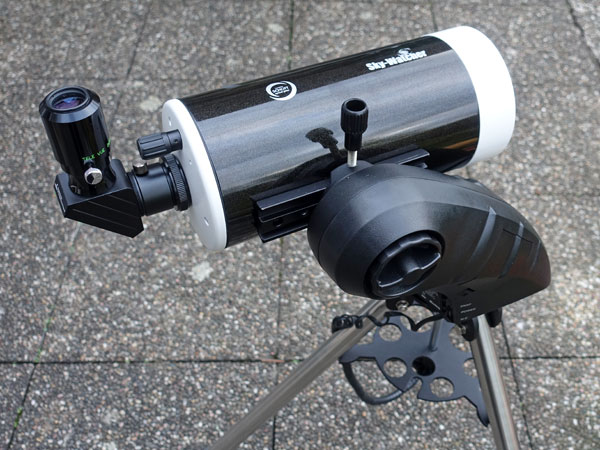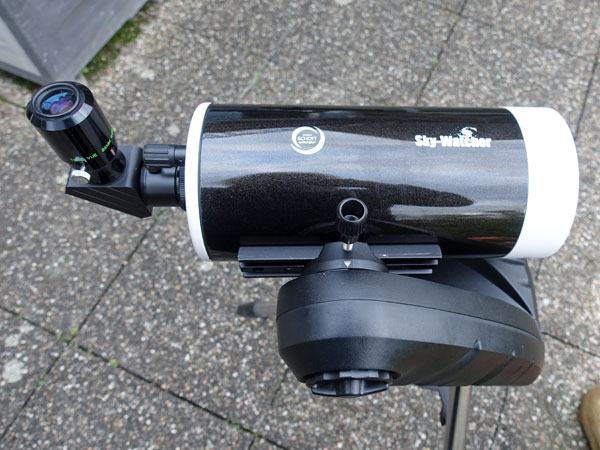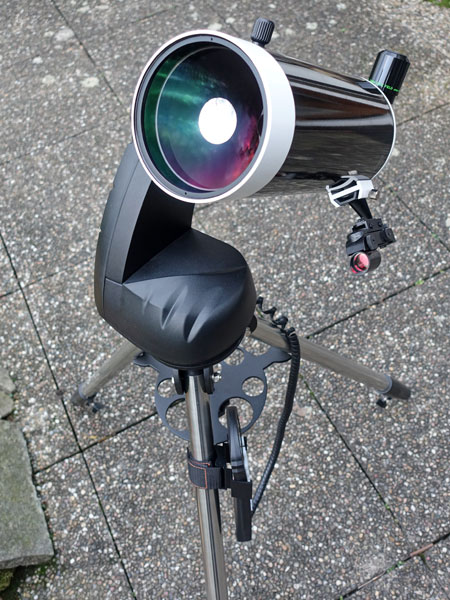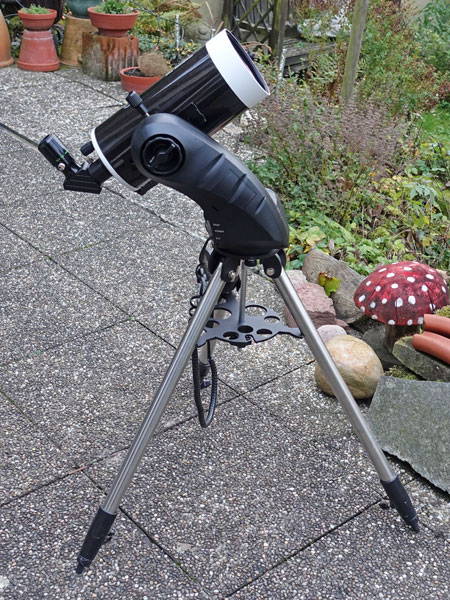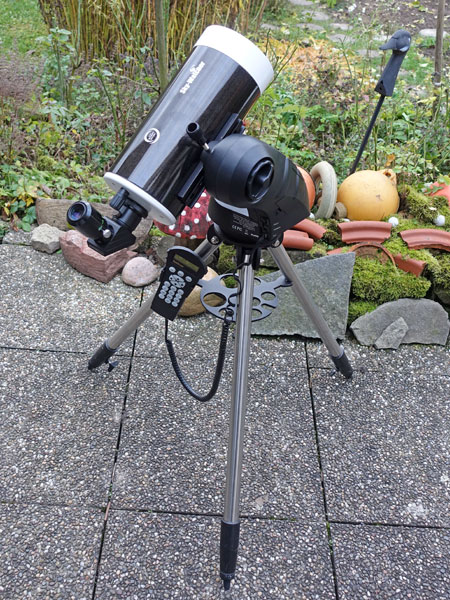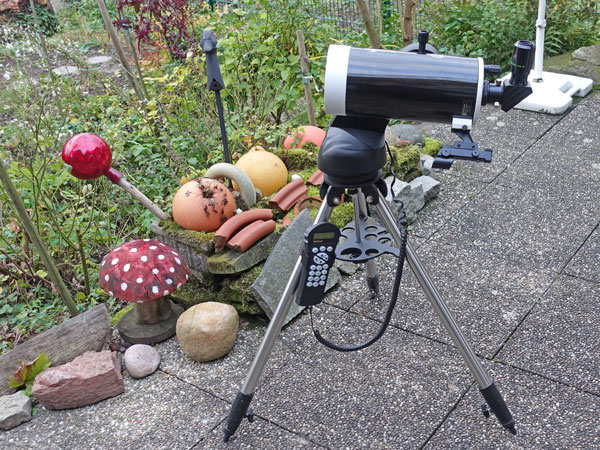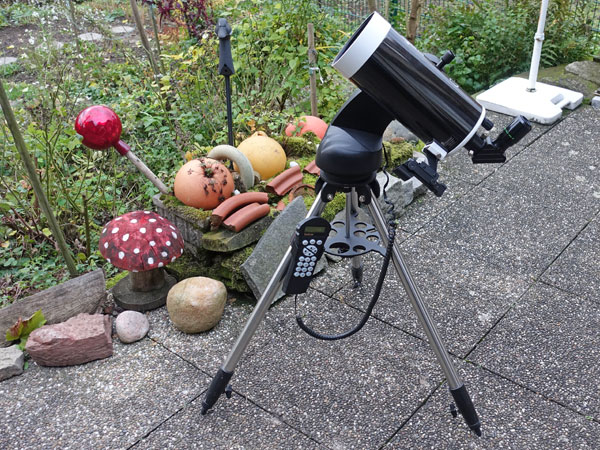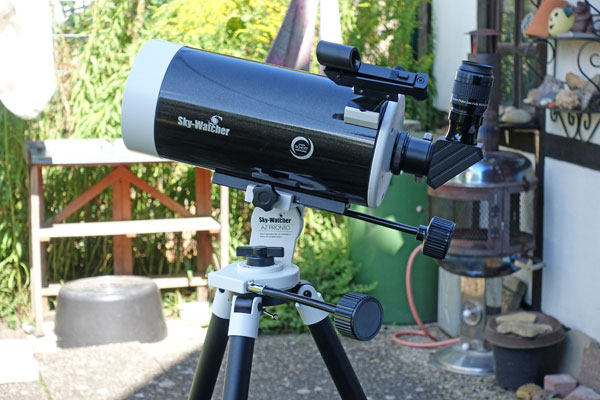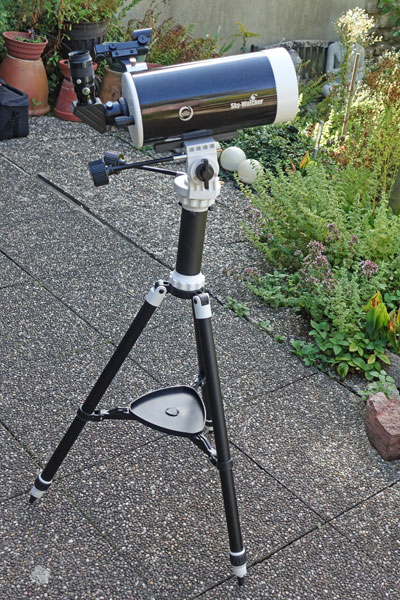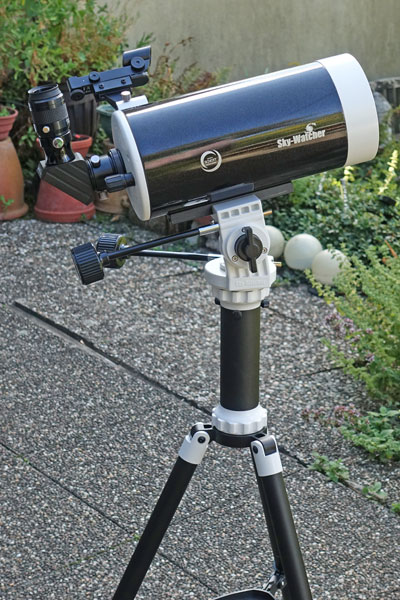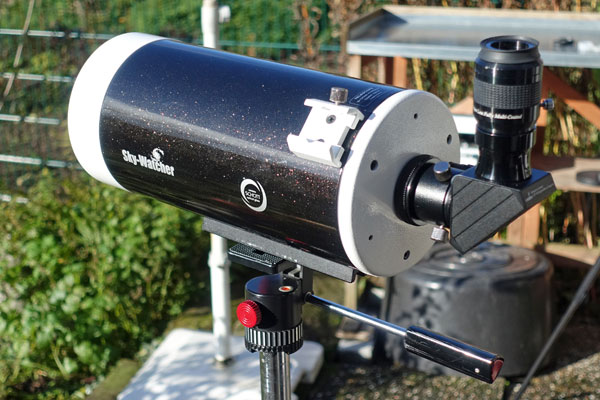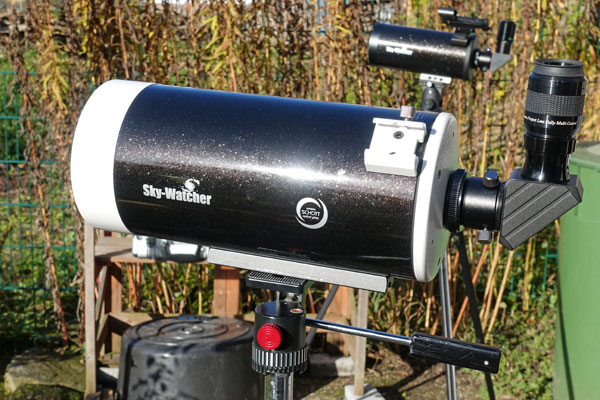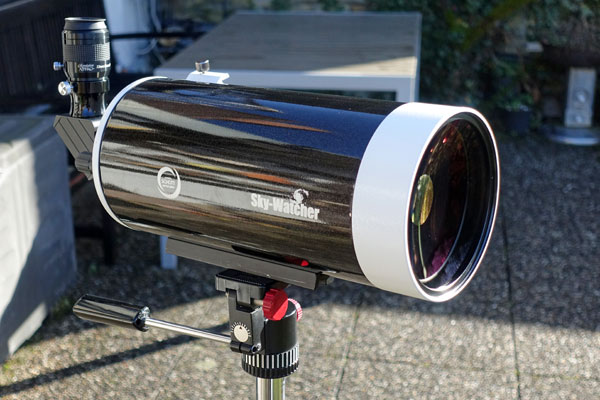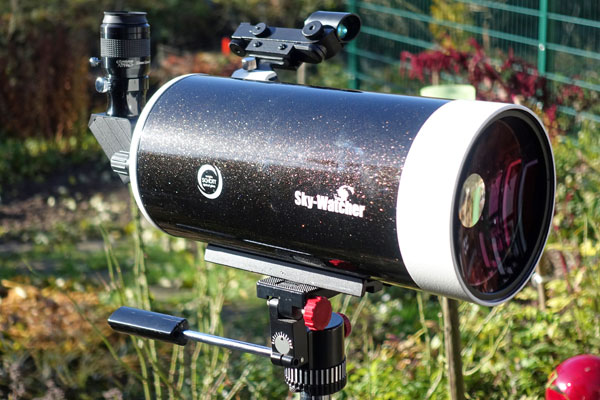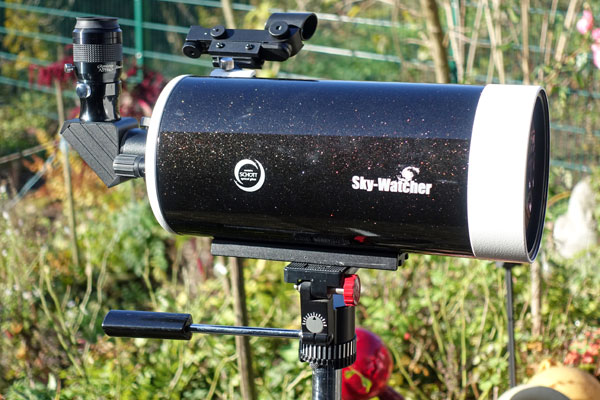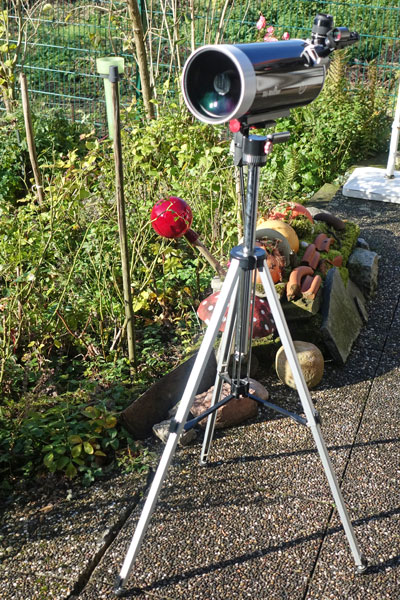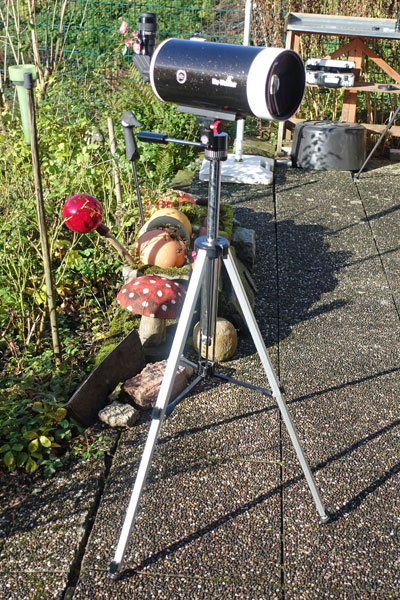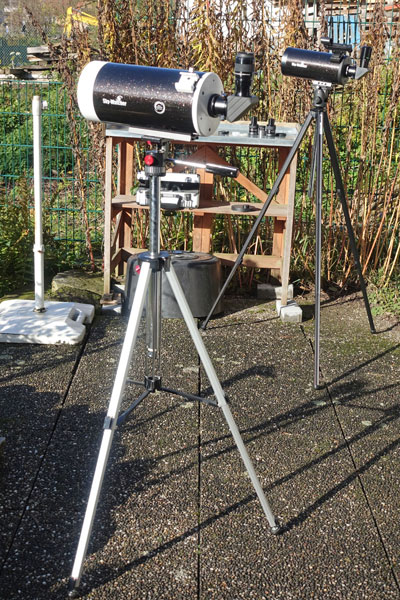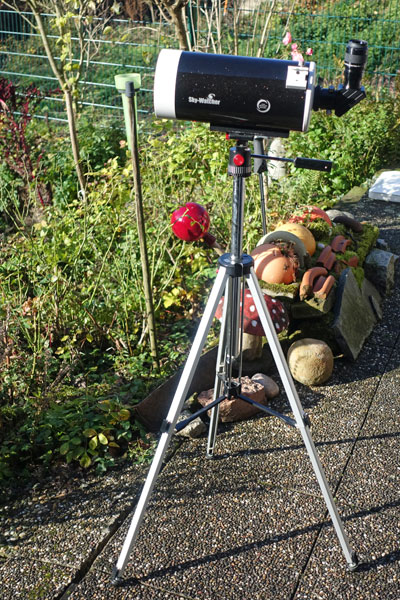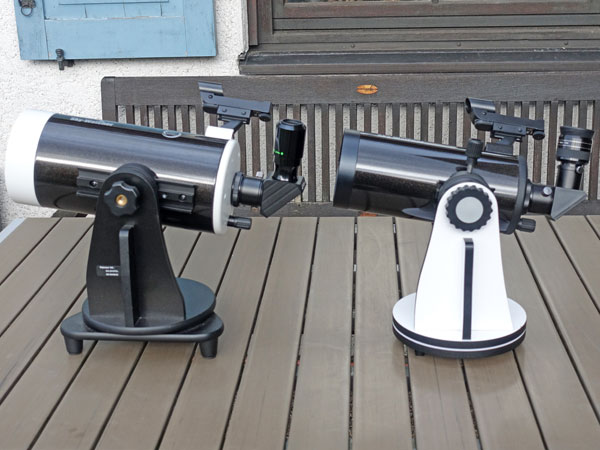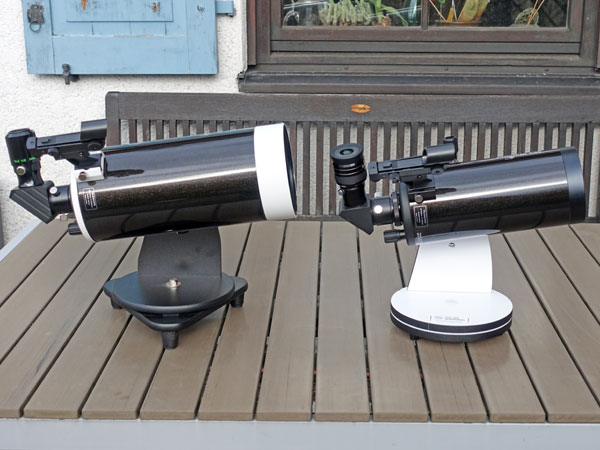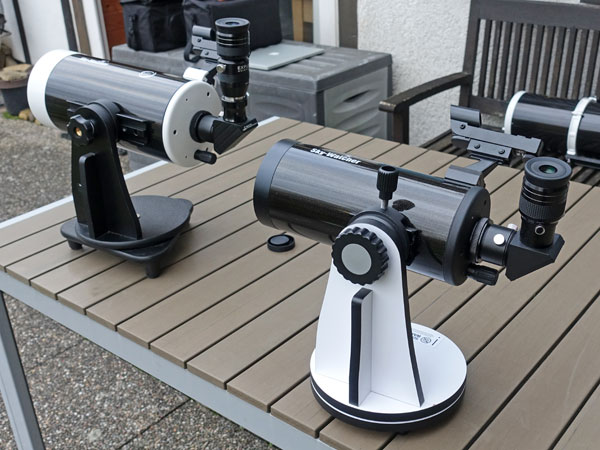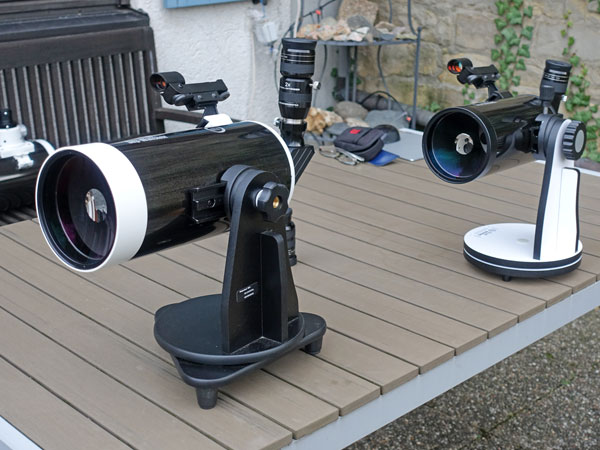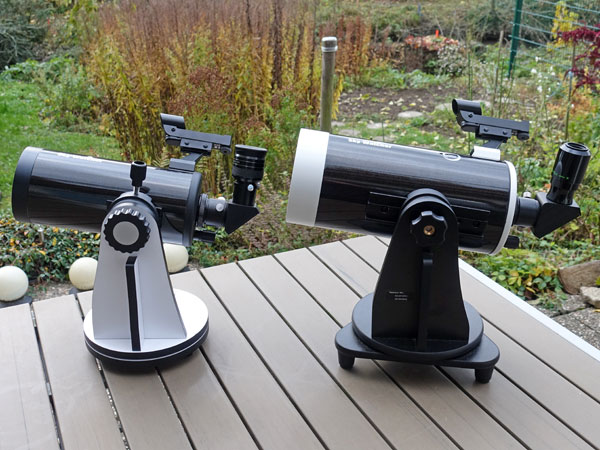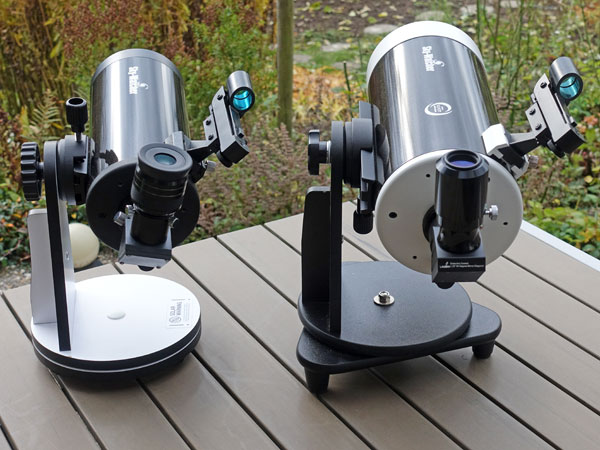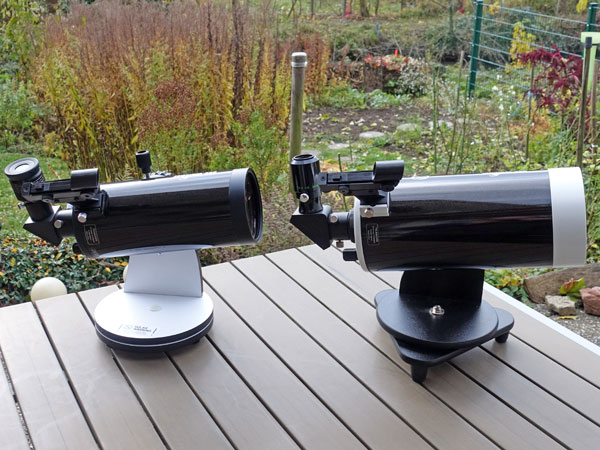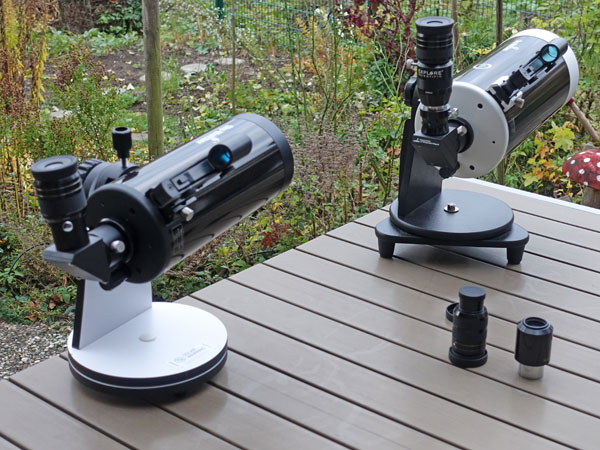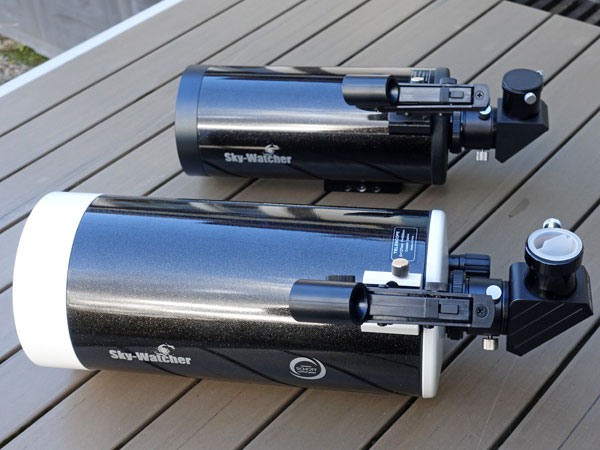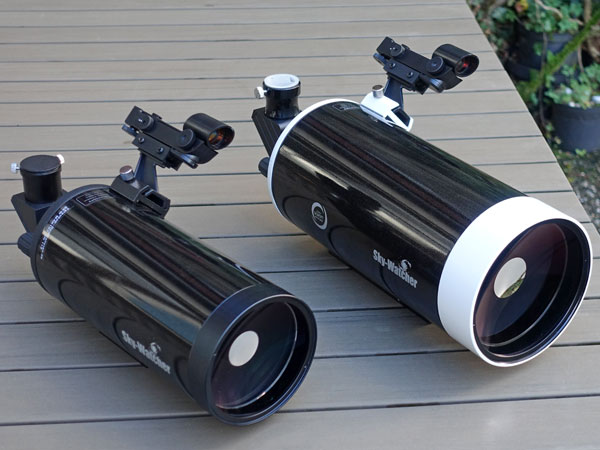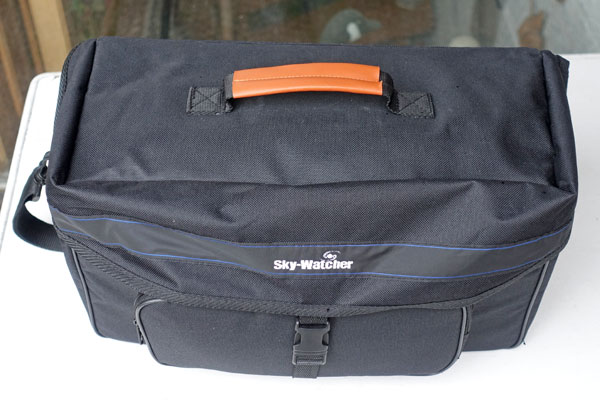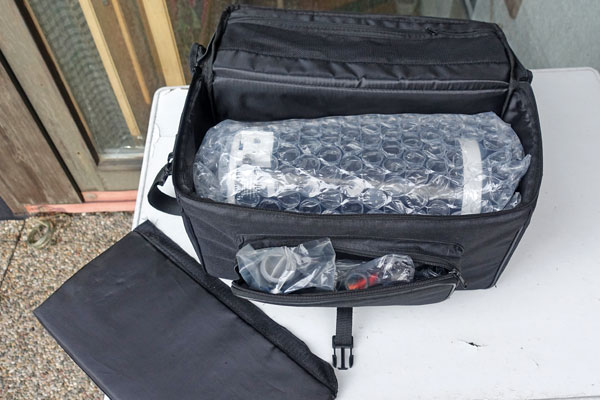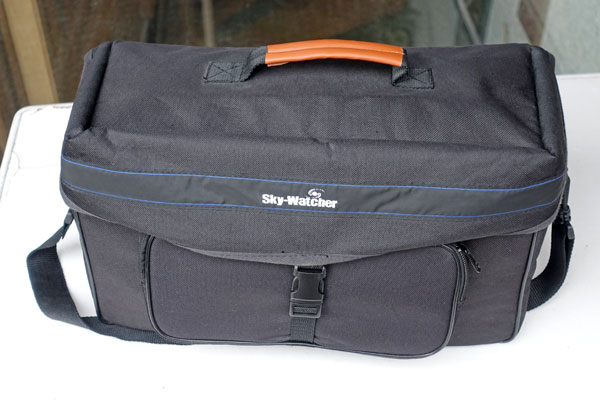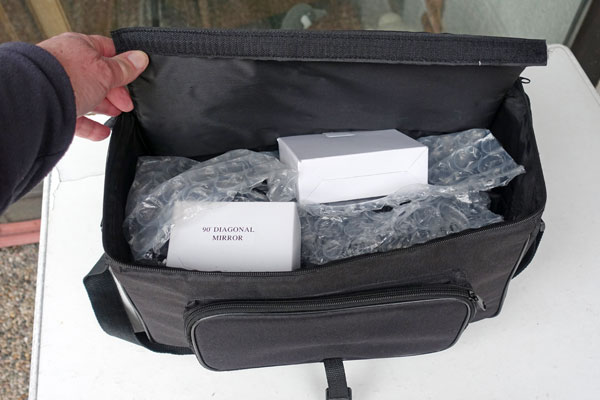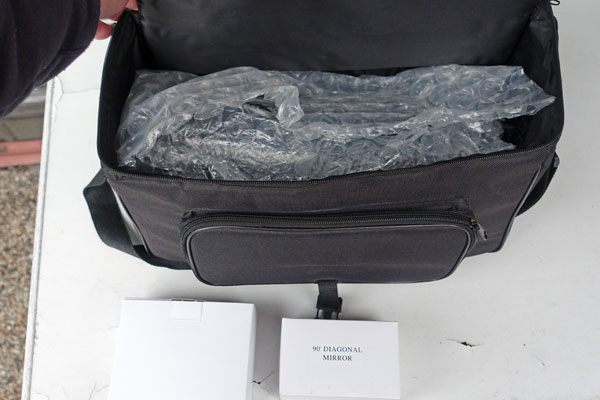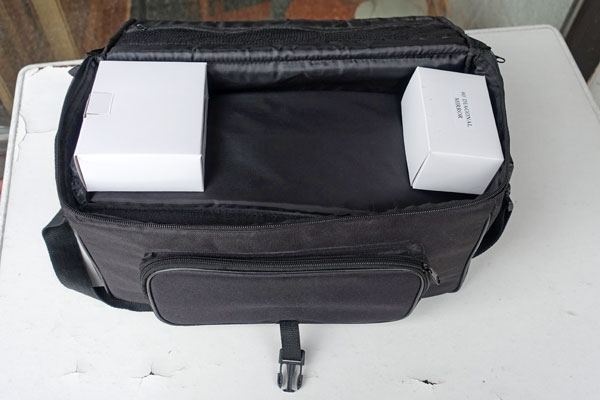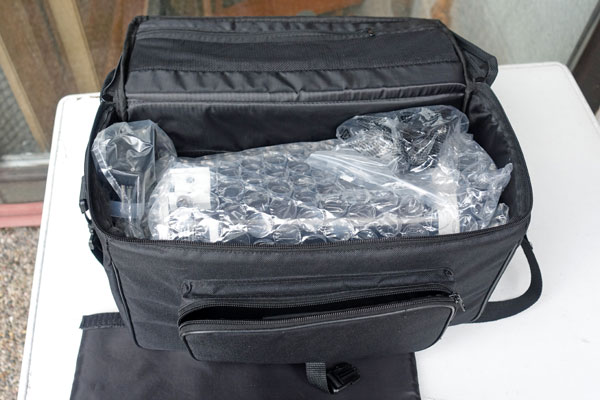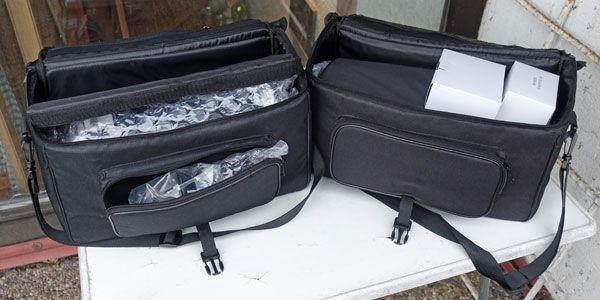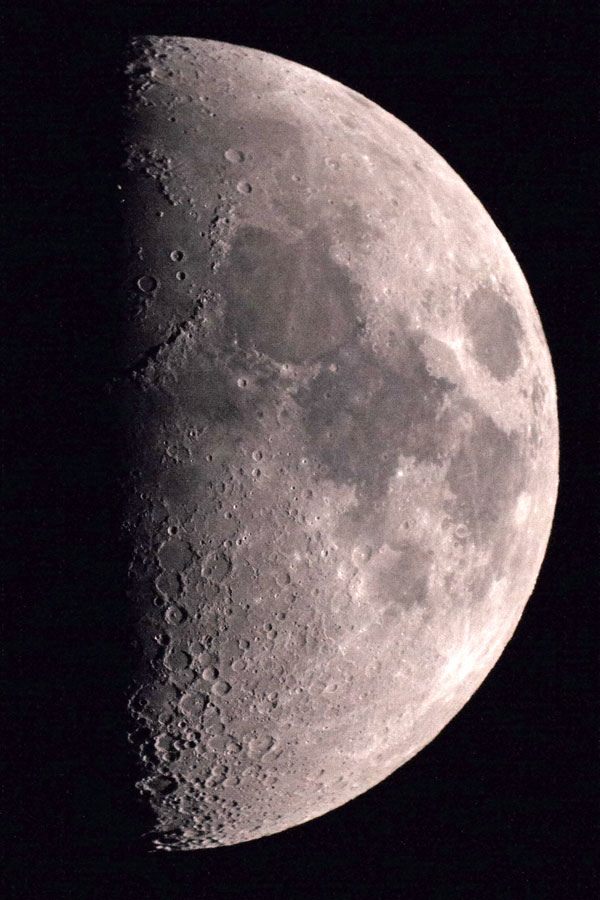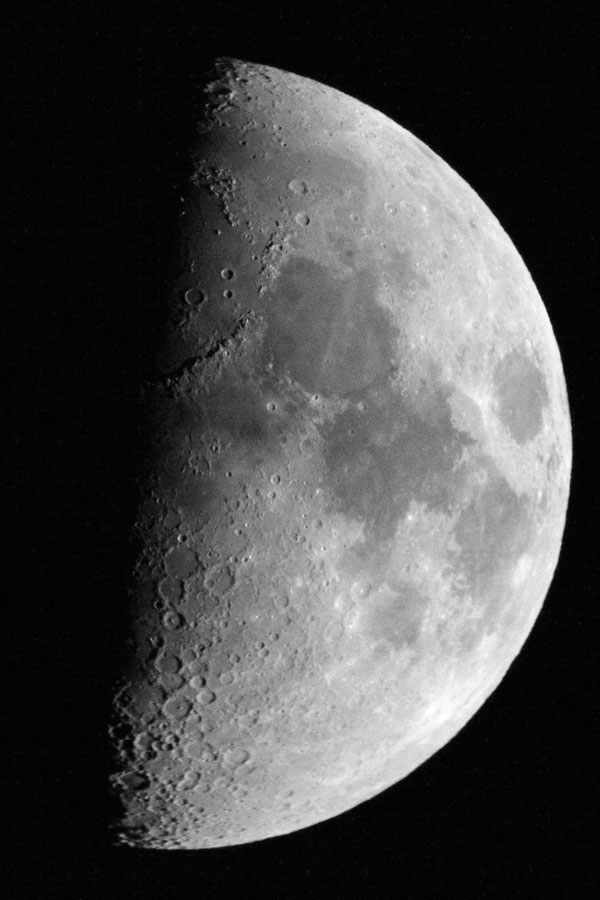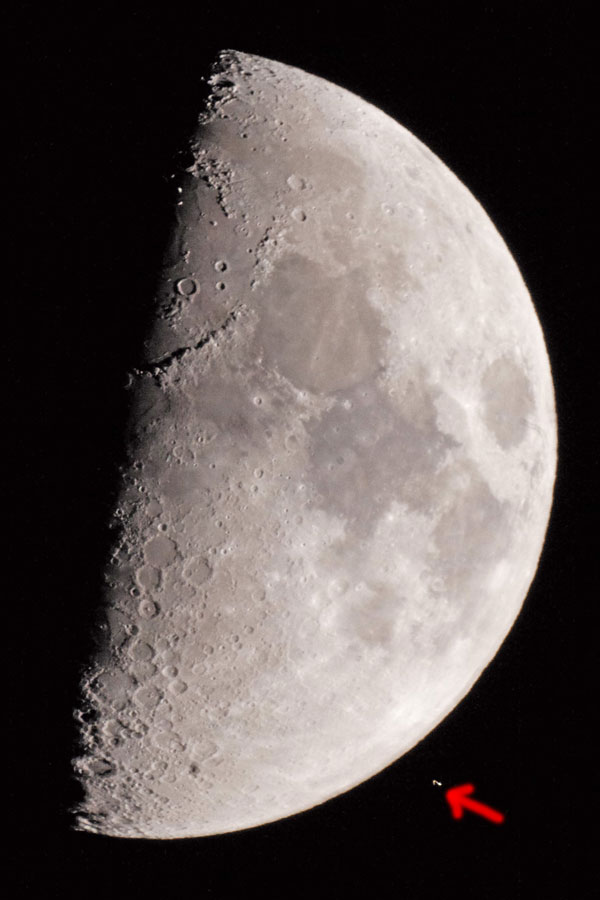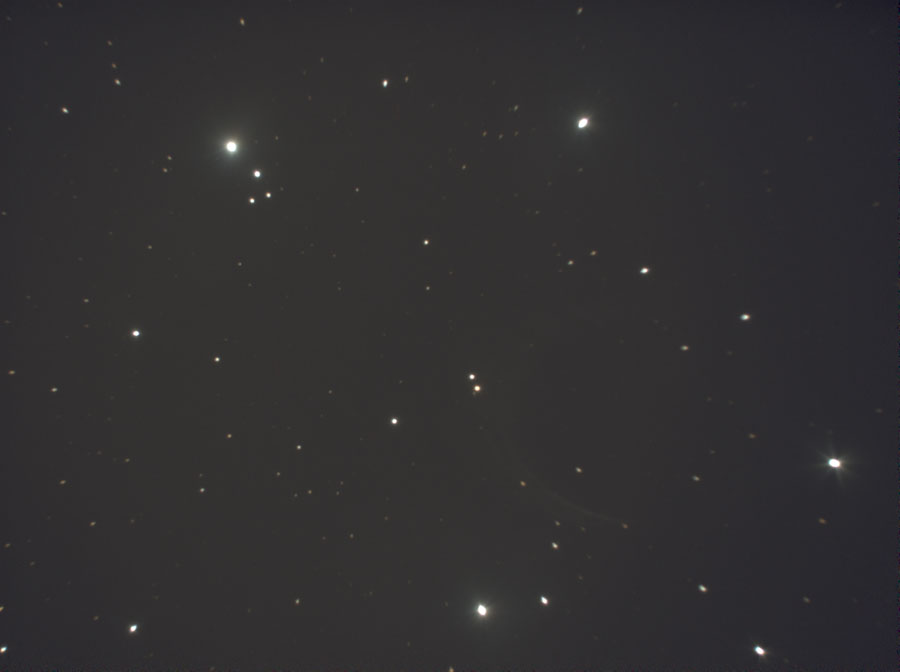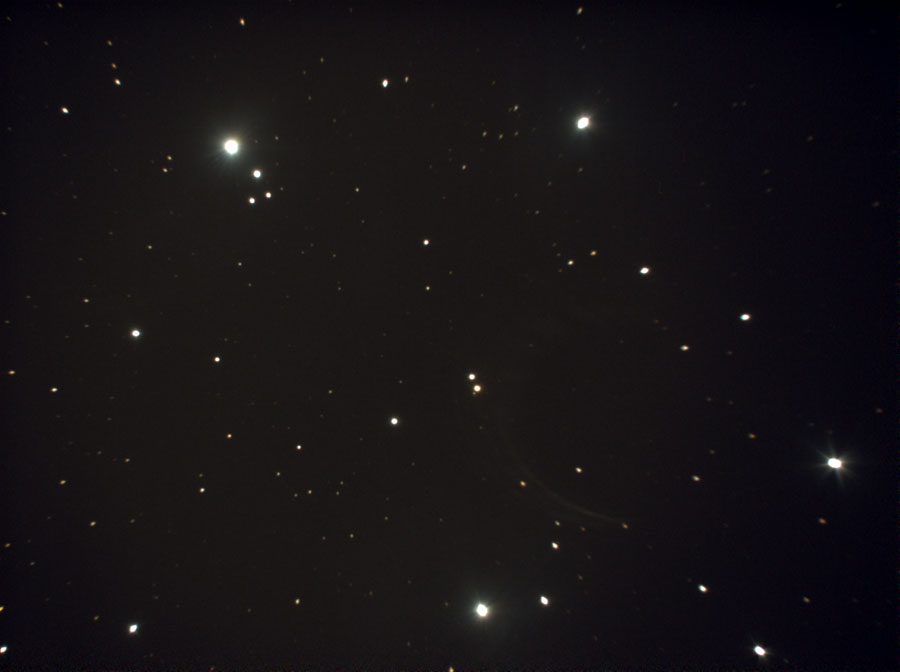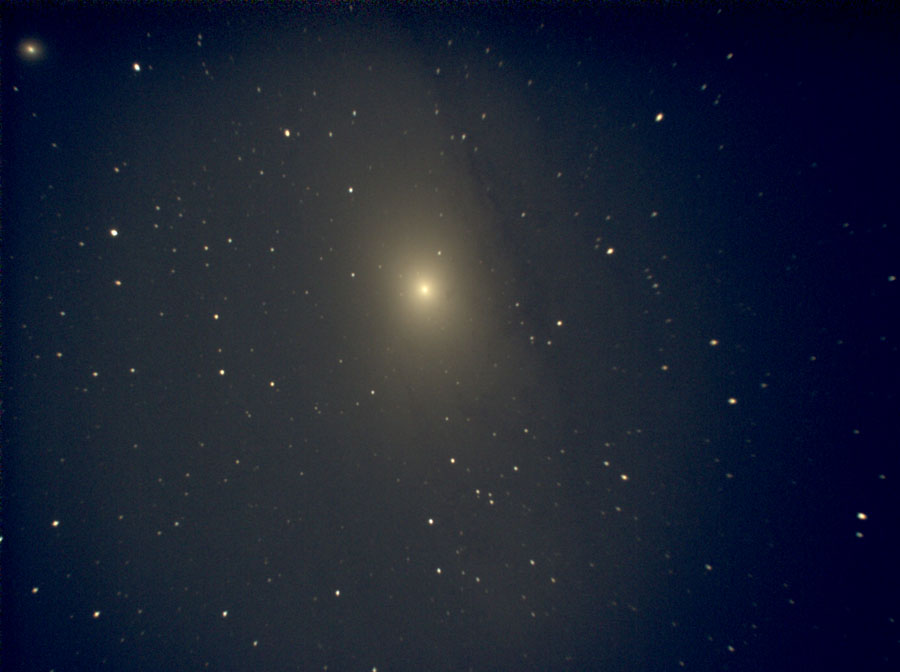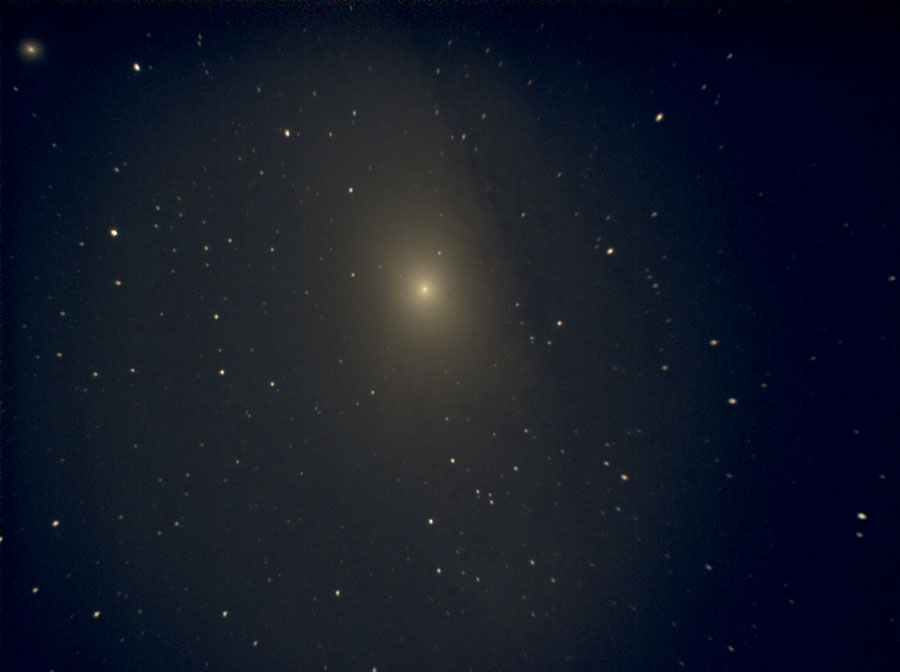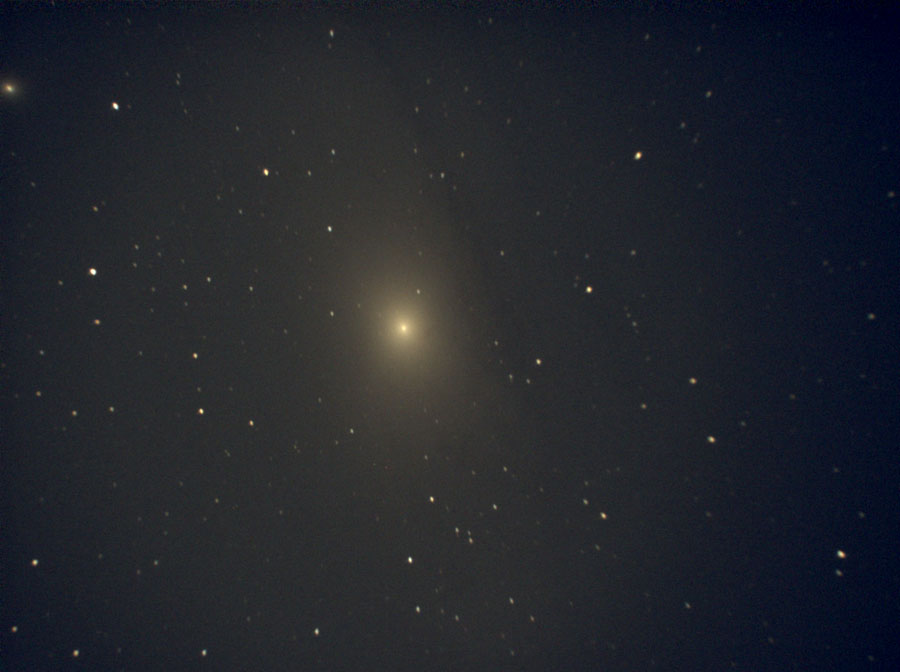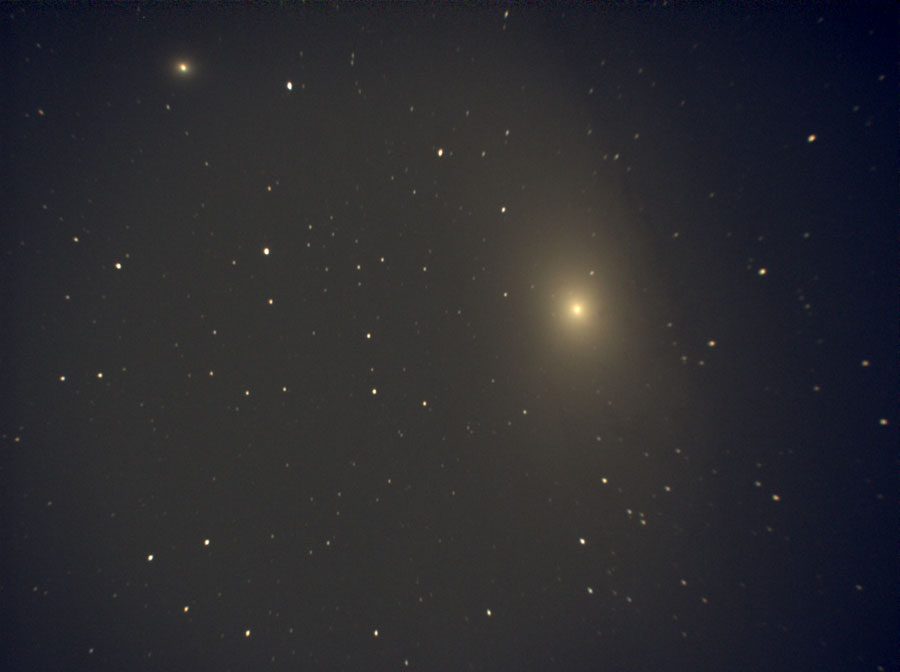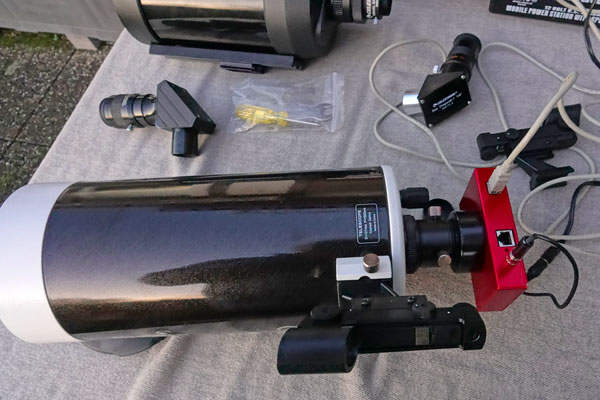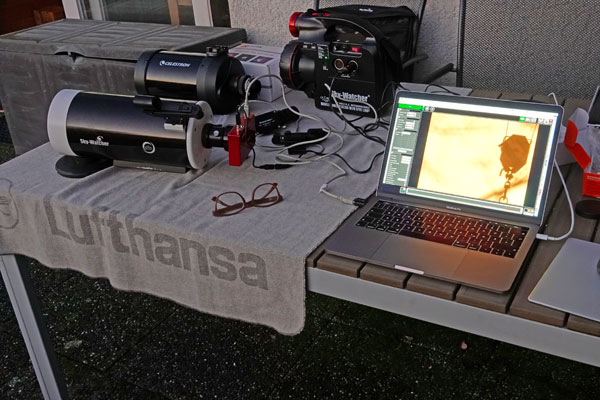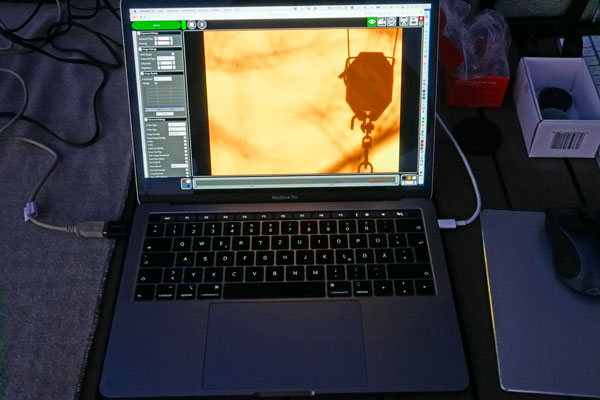Sky-Watcher Skymax-127 OTA Information (5" Maksutov-Cassegrain)
Motivation | Look | Look on Different Bases | Look of the Skymax-127 OTA Compared with the Skymax-102 OTA | Visited Sky Objects | First Photo Attempts | Preliminary Conclusions | Links | Appendix: Data
Archive
On this page, I present some information about my Sky-Watcher Skymax-127 OTA (BKM127OTA) (bought used on November 18, 2017; originally bought in August 2012; sold on January 30, 2021, rebought at the end of October 2021; finally sold at the end of October 2024). It is a 127 mm/1500 mm Maksutov-Cassegrain tube, which primarily is suited to observing the moon, the sun, and the planets; but it also suited to observing brighter DSO.
See also page Sky-Watcher Skymax-127 OTA - Further Experiences (2" accessories, f/6.3 reducer/corrector).
Notes
The Skymax-127 OTA is sold with the following accessories:
- Red dot finder (Starpointer)
- 1.25" diagonal mirror
- 1.25" eyepieces - 25 mm and 10 mm focal length
I purchased the tube used and without a red dot finder and eyepieces, but with a better Lacerta diagonal mirror (99% transmission instead of 91%). In addition, I got the original diagonal mirror that was used to build an angle finder. That is why I bought a red dot finder, I had eyepieces anyway.
| Note: I sold my Sky-Watcher Skymax-127 OTA to a star friend at the end of October 2024. I therefore can no longer report any further experiences with this tube here. |
Motivation
Why did I buy the Sky-Watcher Skymax-127 OTA and for what purpose?
First of all, I already owned a Skymax-102 OTA, which my astronomy dealer had recommended to me and with which I was very satisfied. The Skymax-102 OTA is a Maksutov Cassegrain tube and combines a high magnification with compact dimensions and a reasonable weight, but at the expense of light intensity. This makes it a typical "moon, sun and planets" telescope. The Skymax-127 is the same in a little bit larger version...
However, I have always thought of replacing the Skymax-102 with the more powerful Skymax-127 having an aperture of 127 mm. My astro dealer suggested this step as a possible "optimization" of my telescope collection (but later he withdrew this...). And that is exactly what happened in November 2017, when I found an offer for a used Skymax-127 OTA and bought it spontaneously! Like its little brother, the Skymax-127 now serves special purposes that Newton tubes cannot serve as well. While DSO observations are not regarded as a strength of this tube, I was also able to observe a number of brighter deep sky objects, in contrast to the disappointing Meade ETX 90/EC. But actually, the Skymax-127 corresponds more to its bigger "brother" ETX 125...
Side view of Skymax-127 on AZ Pronto mount with extension tube |
Ditto (detail) |
Other side, on AZ Pronto mount without extension tube |
Ditto (detail) |
At the beginning, it was not clear to me, whether I should keep both Skymax-OTAs in the long run. Actually I did not want to have two similar tubes in my telescope park. Several comparisons showed only a small superiority of the Skymax-127, if at all, and therefore did not help with the decision making... In any case, with the Sky-Watcher AZ Pronto I found a mount, on which I can operate the 127er-Tubeus more or less securely (actually its load capacity is not suffcient...). Before that I had used the tube only rarely due to the lack of a stable mount. In August 2018, I had the opportunity of selling the Skymax 102 tube - and I took it.
Look
The Tube and more...
|
Skymax-127 in its package made by the previous owner plus a self-made angle finder |
Tube taken out of the package |
Ditto |
|
Diagonal mirror used by... |
...the previous owner ... |
...to build an angle finder |
|
Better diagonal mirror (Lacerta) bought by the previous owner |
Ditto |
The previous owner removed
the diagonal mirror and used it to build an angle finder. He replaced
it with a better Lacerta diagonal mirror with better transmission (99%
instead of 91%). |
|
Lacerta diagonal mirror attached |
Ditto |
Original Sky-Watcher diagonal mirror shown at Skymax-102 |
Collimation
|
The 6 Allen screws for collimation at the rear end of the tube |
The main mirror of the Sky-Watcher Skymax-127 OTA can be adjusted using 6 Allen screws, which are located at the rear end of the telescope. The small Allen screws are used for locking, the large ones for adjustment. Instructions from Teleskop-Express (translated, original in German): The collimation should be done directly at a star. Make it out of focus at a magnification of about 100 x. A dark shadow (the secondary mirror) should be exactly at the center. If it is not, you should adjust the telescope. Please proceed as follows:
The telescope is now collimated and will give you the best possible performance. |
|
Look on Different Bases
Telescope Tube on Heritage 100P Base
Actually, the 100P base is too small for the Skymax-127 tube. This is just a preliminary "quick-and-dirty" solution, until I get something that is better suited to the tube (the Heritage P130 base or the one from the Orion N 114/450 StarBlast 4.5 are probably suitable, but can regrettably not be purchased without tube).
|
Skymax-127 on Heritage 100P base |
Ditto |
Ditto, rear view (see the collimation screws) |
|
Skymax-102 on Heritage 100P base, front view |
|
View into the telescope |
The tube is mounted against the "official" viewing direction so that the finder is usable (I discussed this issue for the Skymax-102 at length...)
Telescope Tube on Star Discovery AZ GoTo Mount
When I use the tube on my Star Discovery AZ GoTo mount, this regrettably results in an unusable position of the red dot finder*.
|
Skymax-102 tube on the GoTo mount |
Ditto |
View from above - you can see the label indicating that Schott glass is used |
|
Front view - you can clearly see the impractical position of the finder |
Side view (overall view) |
Seen from the back (overall view) |
|
Skymax-102 tube on GoTo mount (overall view) |
Ditto |
|
I will, as for the Skymax-102, have to find a solution for the finder positioning problem. What about a magnetic foot that still does not turn???
*) The OTA versions are meant to be used on an EQ mount and therefore do not fit optimally AZ mounts and Dobsonian bases.
Telescope Tube on AZ Pronto Mount
Last, but not least, I use the Skmax-127 tube on my AZ Pronto mount. The Skymax-127 OTA weighs more than 3 kg and can therefore be used only with caution on this mount.
Without Extension Tube
Side view |
Ditto (detail) |
Other side |
Ditto (detail) |
With Extension Tube
Side view |
Ditto (detail) |
Other side |
Ditto (detail) |
Telescope Tube on Photo Tripods
The Skymax-127 OTA can also be used on photo tripods, but it is bulky and already a bit heavy (> 3.4 kg with accessories). This is also recommended for daytime use, when you use the tube as a "spotting scope" (the image is upright, but reversed; an Amici prism would provide a "normal", that is, upright and correct, view).
Look of the Skymax-127 OTA Compared with the Skymax-102 OTA
The Skymax-102 is here used on a Omegon Mini Dobsonian mount, which actually is too shaky for the tube. But using the Skymax-127 on the Heritage 100P base is not much better either...
|
Skymax-127 (left) and Skymax-102 (right), front view |
Ditto, side view |
Ditto, seen from the other side |
|
Ditto, rear view |
Ditto, oblique side view |
Ditto, oblique view from side |
|
Ditto, other view from the side |
Ditto, rear view |
Ditto, seen from the other side |
|
Ditto, seen from the rear |
The OTAs only |
Ditto, front view |
Skymax Tubes in Sky-Watcher Bag
|
Skymax-127 in bag |
Ditto, bag open |
Ditto, accessories visible |
|
Skymax-102 in bag |
Ditto, bag open, accessories in boxes can lie on the tube |
Ditto, accessories removed |
|
Ditto, the accessories can also be placed this way |
Skymax-127 in bag, accessories next to or on tube |
Both tubes with their accessories in their bags |
Visited Sky Objects
So far, I have visited (and documented...) the following sky objects with the Sky-Watcher Skymax-127:
- Moon (Photos of the Moon April 2017, Photos of the Moon May 2017, Moon Covers Aldebaran February 2018, Photos of the Moon February 2018, Photos of the Moon March 2018, Photos of the Moon August 2018, Photos of the Moon November 2018, Total Eclipse of the Moon 2019 (Blood Moon), Partial Eclipse of the Moon 2019)
- Jupiter, Venus (also Half-Venus), Mars, Saturn
- Cr 399 (Coat Hanger, part of...), M 2, M 3, M 4, M 5, M 8 (Lagoon Nebula), M 9, M 10, M 11 (Wild Duck Cluster), M 12, M 13 (Hercules Cluster), M 14, M 15, M 22, M 27 (Dumbbell Nebula), M 31 (Andromeda Galaxy) and M 32 with Atik Infinity camera and 2 x focal reducer plus extension tube (about 3 x reduction), M 35, M 42/43 (Orion Nebula), M 45 (Pleiades), M 53, M 56, M 57 (Ring Nebula), M 71, M 80, M 92, M 107, NGC 663
- Double stars: Epsilon Lyrae (Double Double; August 2018), Albireo (December 2019)
- Comets: C/2020 F3 (NEOWISE)
First Photo Attempts
Photos Through the Eyepiece (Projection Method)
First Moon Photo with the Camera Held to the Eyepiece
The following moon photo was taken on 22.2.2017 (one day before Half Moon). It was taken using the 1:50 method, that is, with the camera held to the eyepiece - in this case it was a Ricoh GR (28 mm equivalent). I used ISO 1600 and underexposed to prevent that bright areas are washed out.
I used a 32 mm Plössl eyepiece because otherwise I would not be able to "catch" the whole moon.
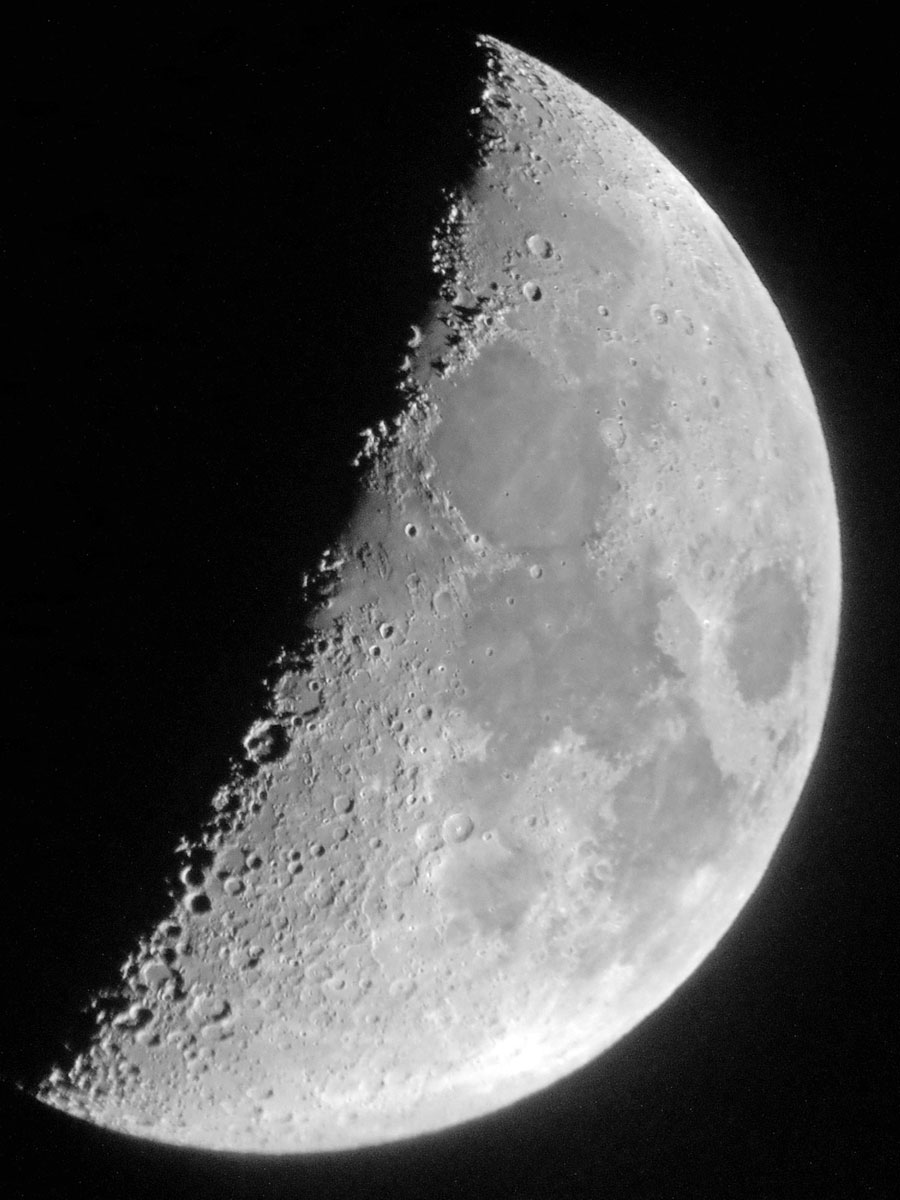 |
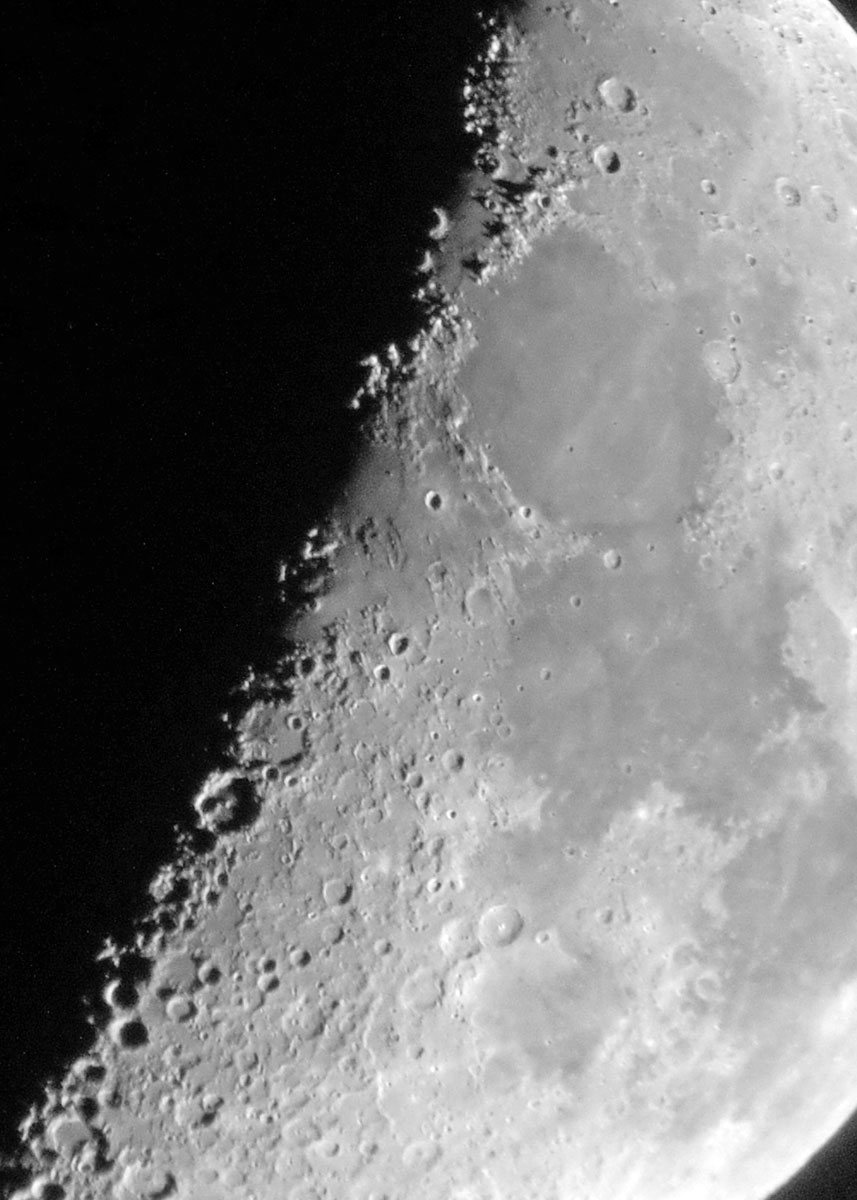 |
|
With 32 mm eyepiece (apr. 47 x) - 2000 pixels |
|
Section - 1400 pixels |
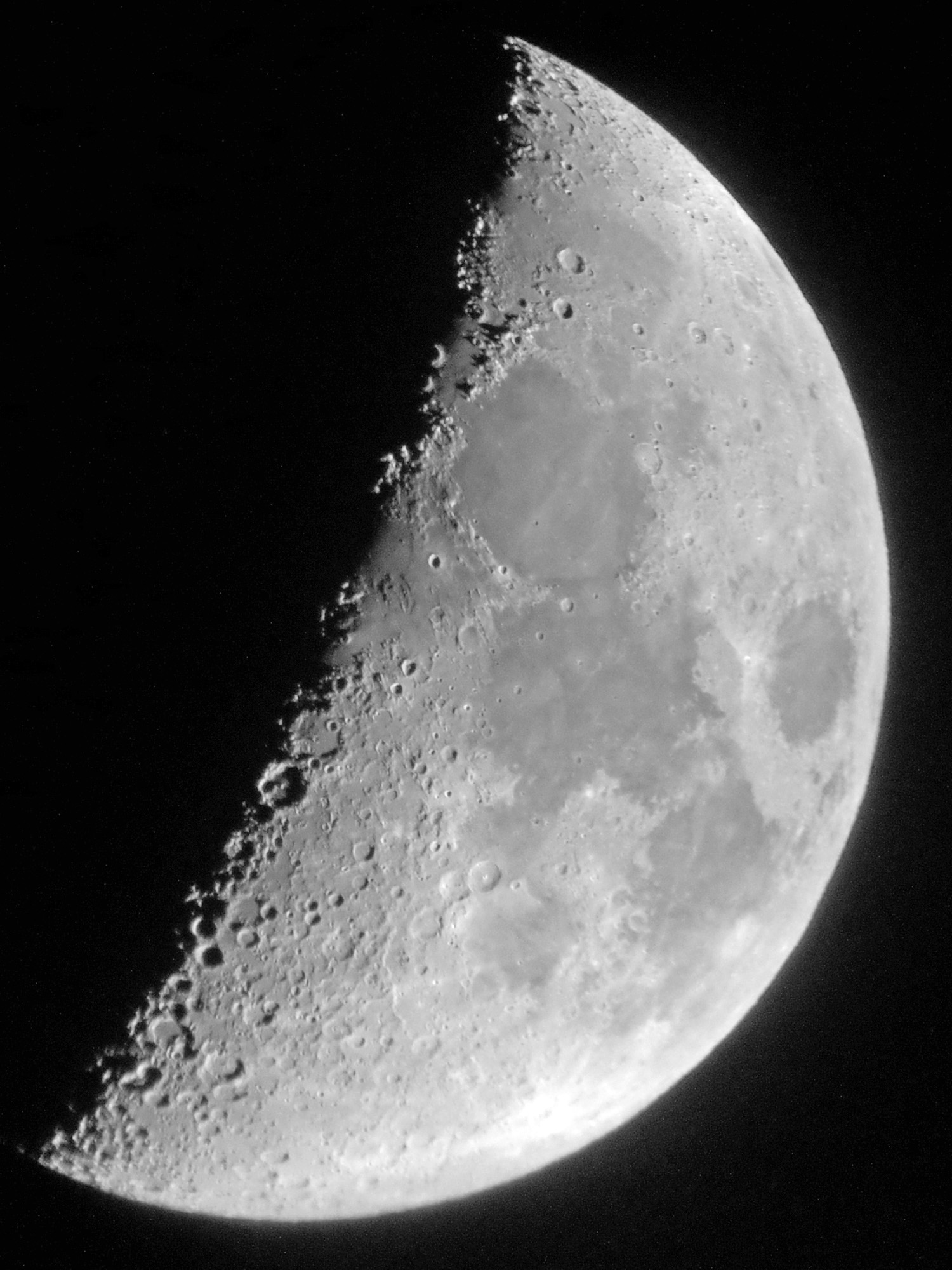 |
||
The same photo larger, with 32 mm eyepiece (apr. 47 x) - 2000 pixels |
||
Photos of the Moon with Camera Screwed to the Eyepiece
On February 27, 2018, I took a series of moon photos with my Leica M (Type 240) and a Minolta 28 mm lens attached to the eyepiece. Most of the resulting photos were, however, blurred. In order to investigate the conditions for the camera shake more closely, I varied the exposure times. My conclusion was that I only get really sharp photos with this combination under lucky circumstances, even exposure time did not matter too much provided that is was not too long (contrary to using this equipment on the Skymax-102...) - but the potential is there!
Conclusion: Only under fortunate circumstances I will get really sharp photos with this combination - but the potential is there! The potential is there, but the results achieved with the Skymax-127 seem to be slightly better than those of the Skymax-102. This may, however, also be due to the selected images or just coincidence... Here are some selected sample photos:
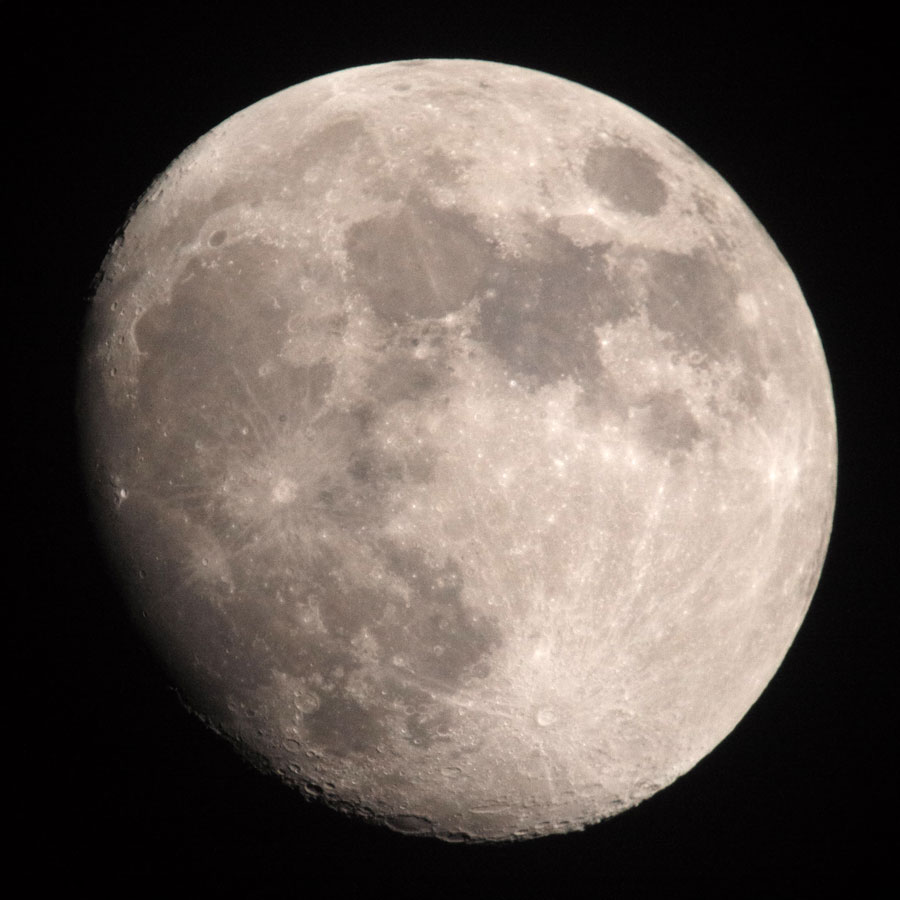 |
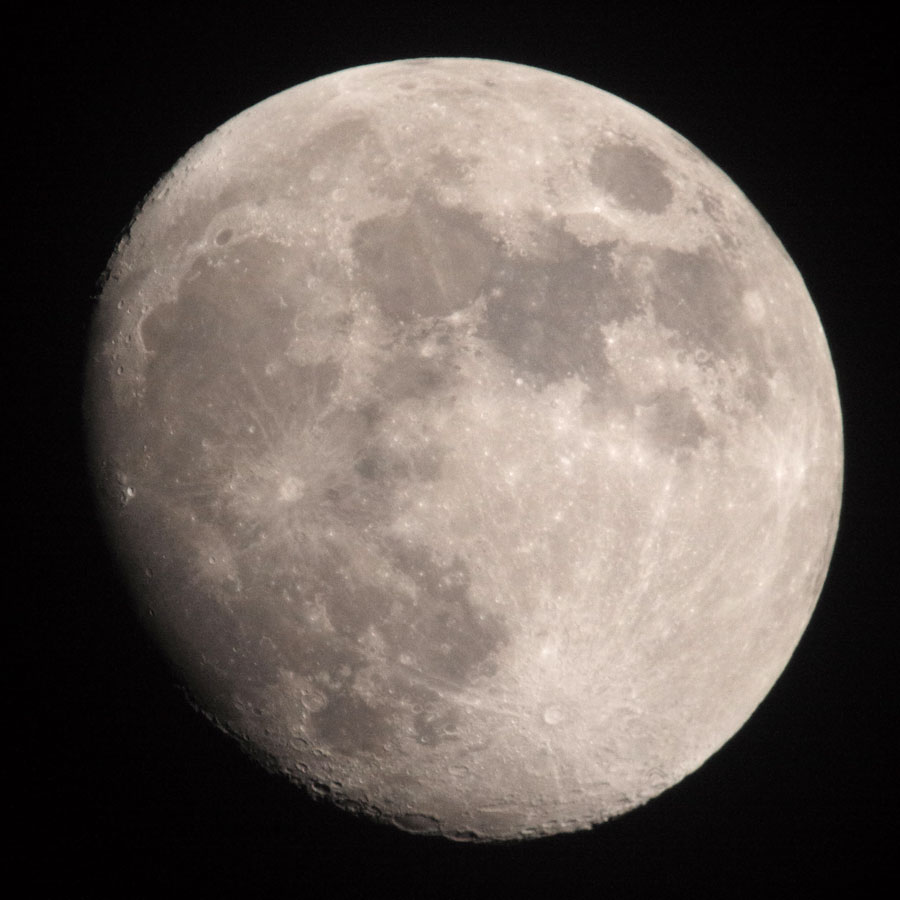 |
|
Post-processed, exposure time 1/750 sec - 2700 pixels |
Post-processed, exposure time 1/750 sec - 2700 pixels |
|
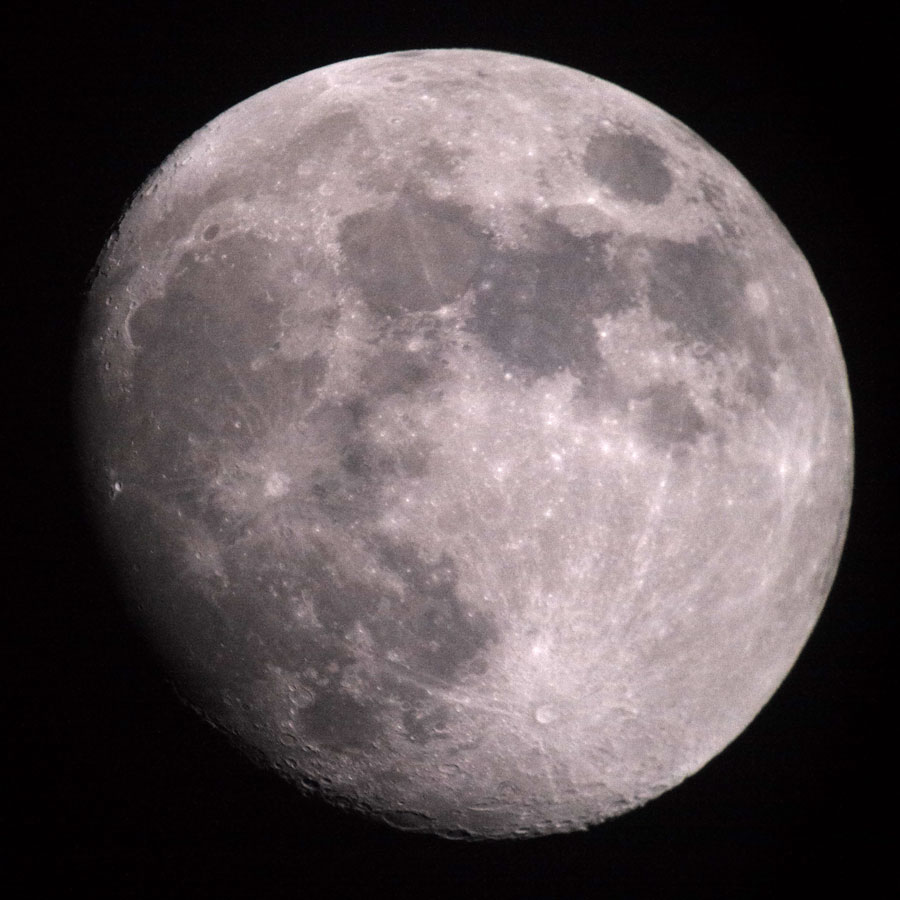 |
 |
|
Post-processed, exposure time 1/1500 sec, somewhat underexposed - 2700 pixels |
Post-processed, exposure time 1/1000 sec, nevertheless blurry - 2700 pixels |
|
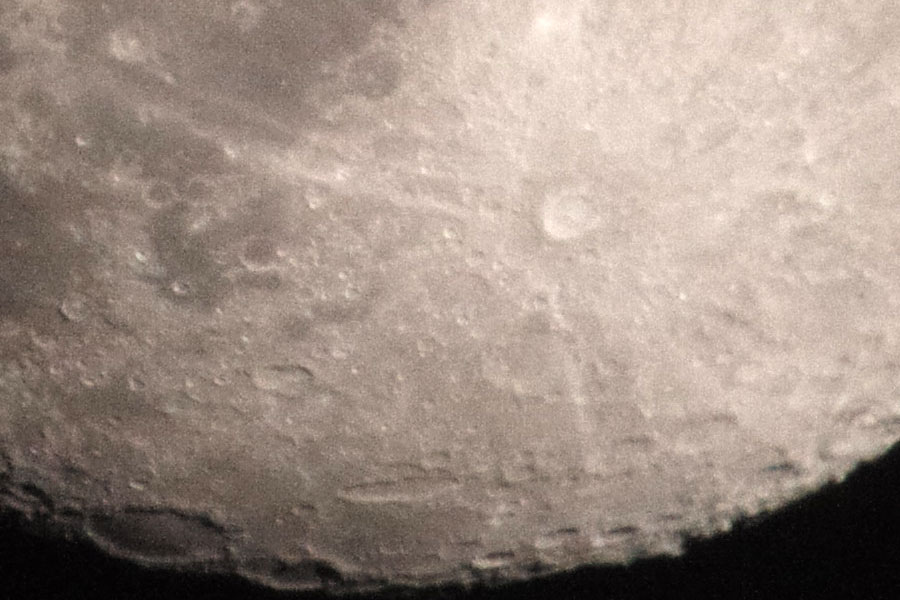 |
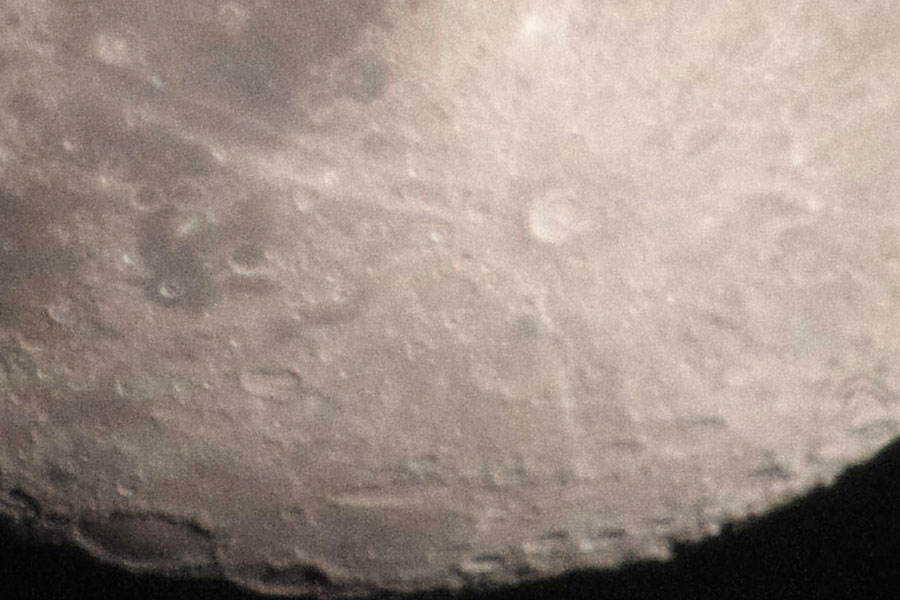 |
|
Section from the southern hemisphere, my sharpest sample |
Ditto; same exposure time, but less sharp |
|
 |
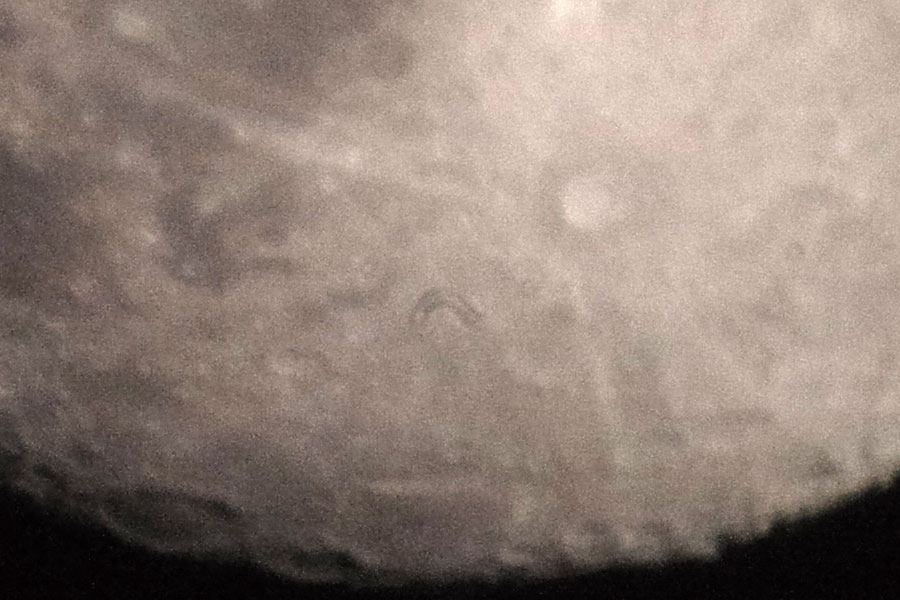 |
|
Ditto; more noise due to underexposure and less sharp than the photo above that has twice the exposure time... |
Ditto; despite of an exposure time of only 1/1000 sec blurred; probably misfocused |
The following photos of the moon were taken on March 25, 2018 using the projections method, that is, with the Sony RX100 M4 attached to the eyepiece. I used ISO 800 and mostly underexposed EV -1 to avoid blowing the highlights. I used a 32 mm Digiscope eyepiece with T-mount.
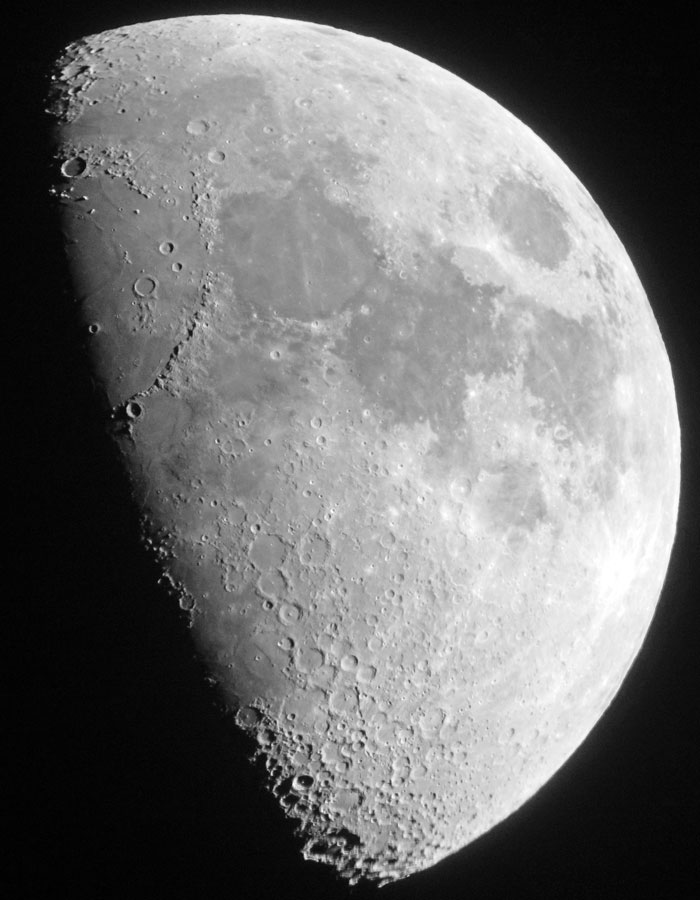 |
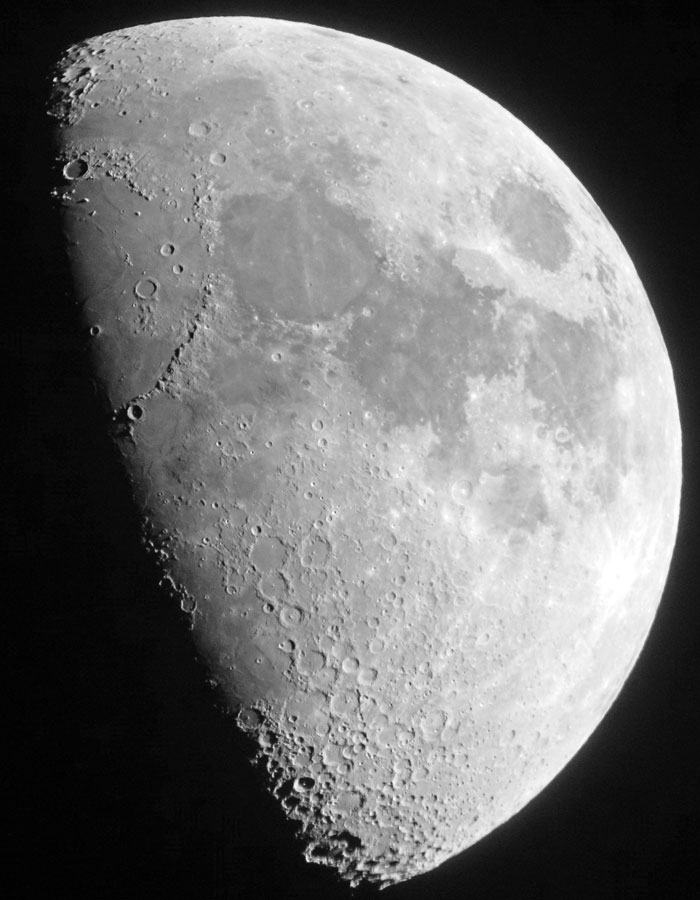 |
|
|
The following photos of the moon were taken on March 29, 2018, two days before Full Moon, using the projections method, that is, with the Sony RX100 M4 attached to the eyepiece. I used ISO 400 and 200 and underexposed EV -2 to avoid blowing the highlights. I used a 32 mm Digiscope eyepiece with T-mount.
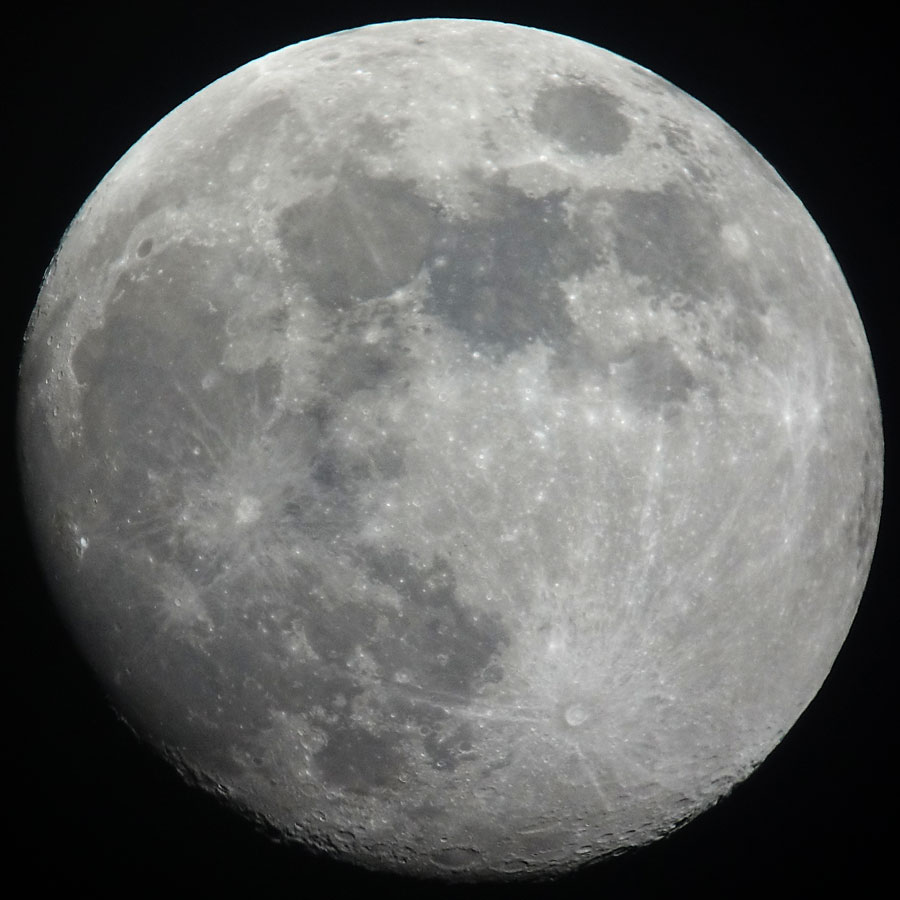 |
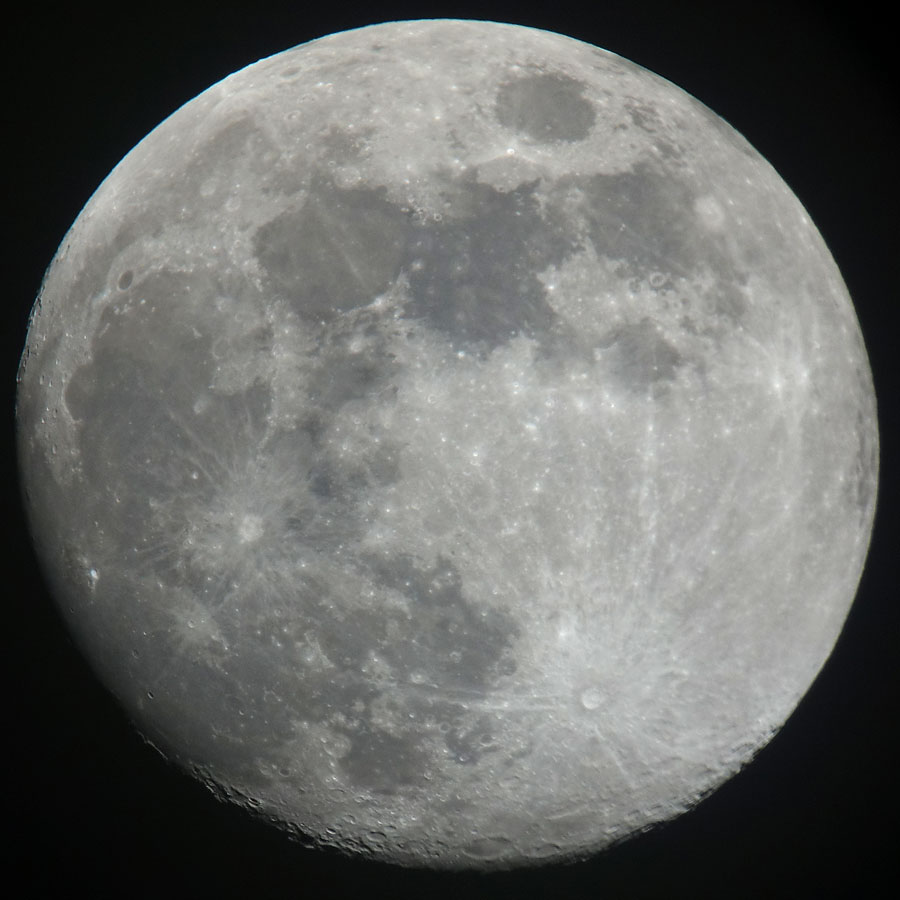 |
|
2200 pixels (ISO 400, 28 mm equiv.) |
2700 pixels (ISO 200, 35 mm equiv.) |
The following photos of Saturn were taken on August 3, 2018 using the projection method, that is, with the Sony RX100 M4 attached to the eyepiece. I used ISO 800 and underexposed to avoid blowing the highlights. I used a 32 mm Digiscope eyepiece with T-mount.
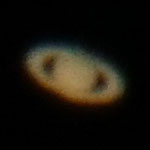 |
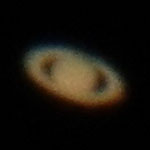 |
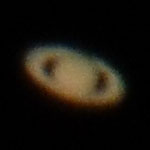 |
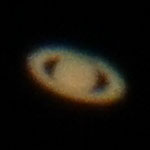 |
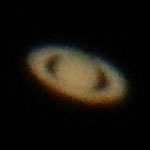 |
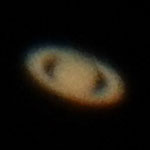 |
|||||
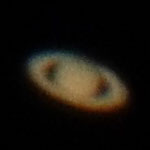 |
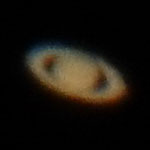 |
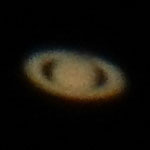 |
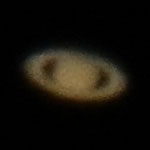 |
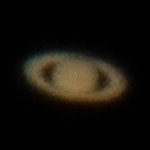 |
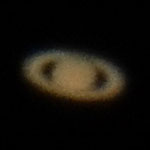 |
|||||
Photos cropped but not processed;all photos were taken with ISO 800 |
||||||||||
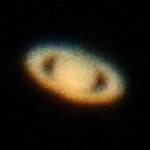 |
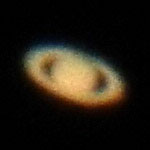 |
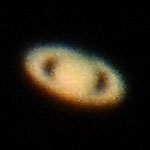 |
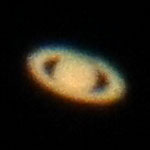 |
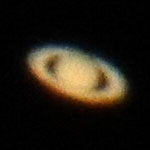 |
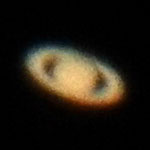 |
|||||
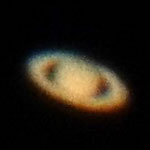 |
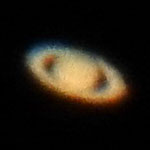 |
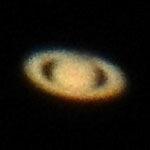 |
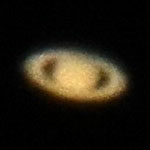 |
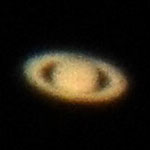 |
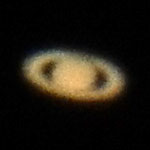 |
|||||
Photos made lighter |
||||||||||
The following photos of Venus (Half-Venus, maximum elongation for 2020) were taken on March 23, 2020 using the projection method, that is, with the Sony RX100 M4 attached to the eyepiece. I used ISO 125 and manual exposure to avoid blowing the highlights. I used a 32 mm Digiscope eyepiece with T-mount.
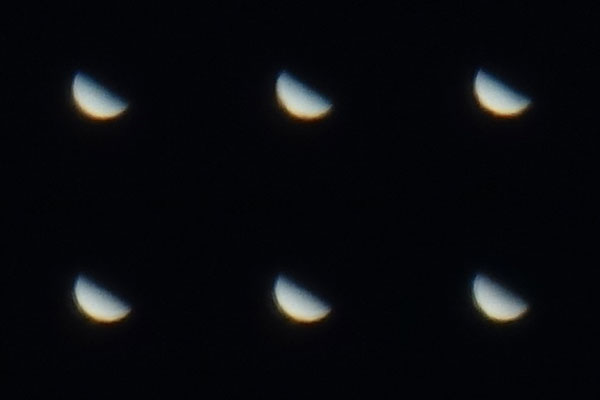 |
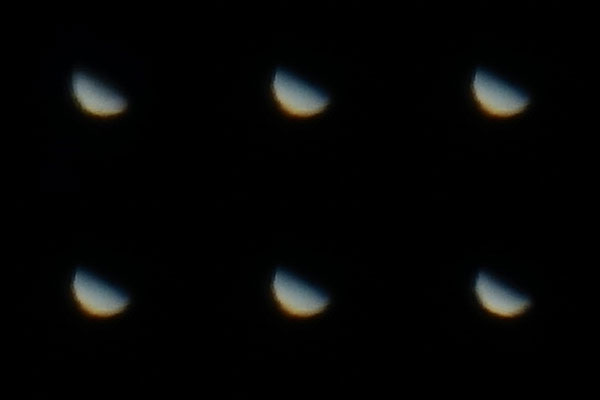 |
|
In the beginning, the sky was still fairly bright, and the Venus stood high in the sky. |
Later the sky was darker, but Venus stood still quite high in the sky. |
The following attempts from April 4-5, 2020 to photograph the Orion Nebula with the Skymax-127 and a normal camera is rather to be understood as fun. But it shows that this is possible in principle.
 |
 |
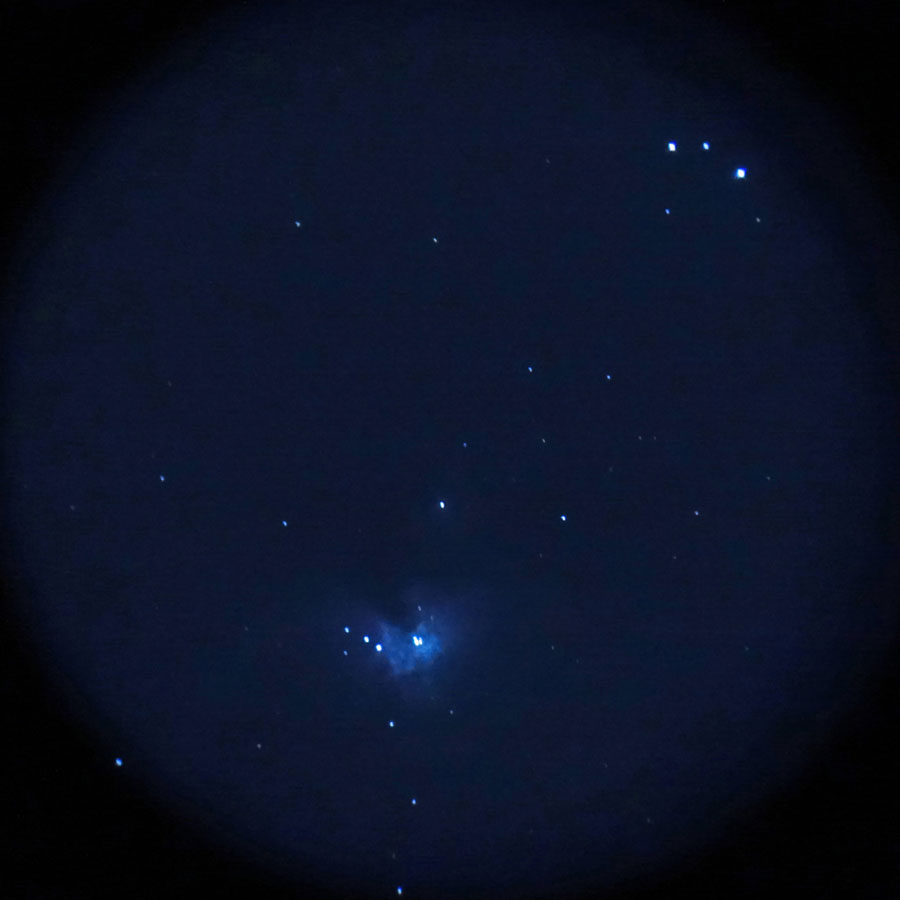 |
||
Orion Nebula with Skymax-127 and RX100 M4 (Apr 4) - 3000 pixels |
Orion Nebula with Skymax-127 and RX100 M4 (Apr 5) - 3000 pixels |
Orion Nebula with Skymax-127 and RX100 M4 (Apr 5) - 3000 pixels |
Photos Using a T-Mount Adapter
On February 23, 2018, I attempted to take photos of the moon covering Aldebaran, using my Skymax-127 OTA and my Leica M (Typ 240) connected by a T-mount adapter. The telescope is used as a camera lens (1500 mm, f/11.8) for this type of mounting. The results are described elsewhere and are overall disappointing, because almost all images are blurred despite using a cable release. Here are some sharper samples:
Sharp, but noisy because underexposed; such a sharp image was rare - 2400 pixels |
Sharp - 2700 Pixel |
The sharpest photo in this group - 2700 pixels |
||
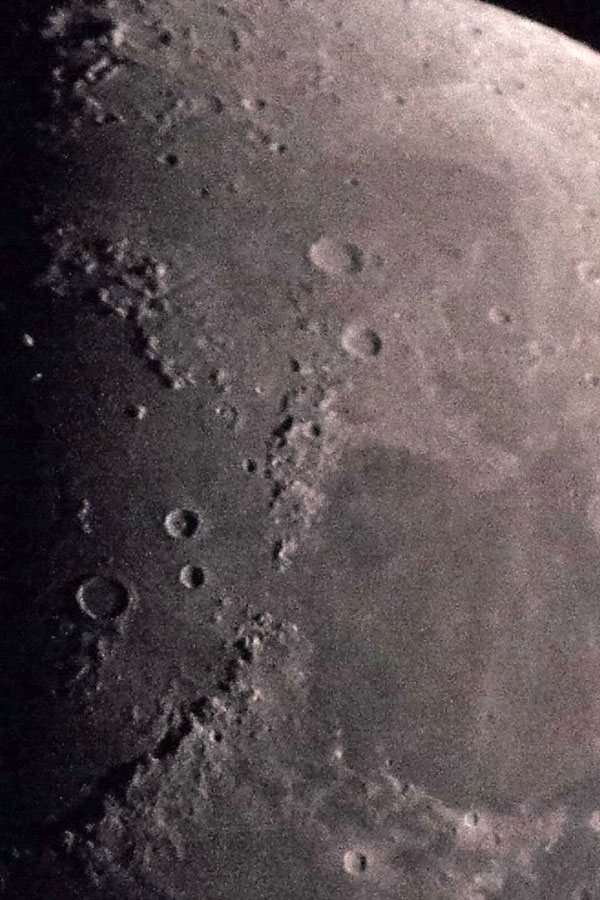 |
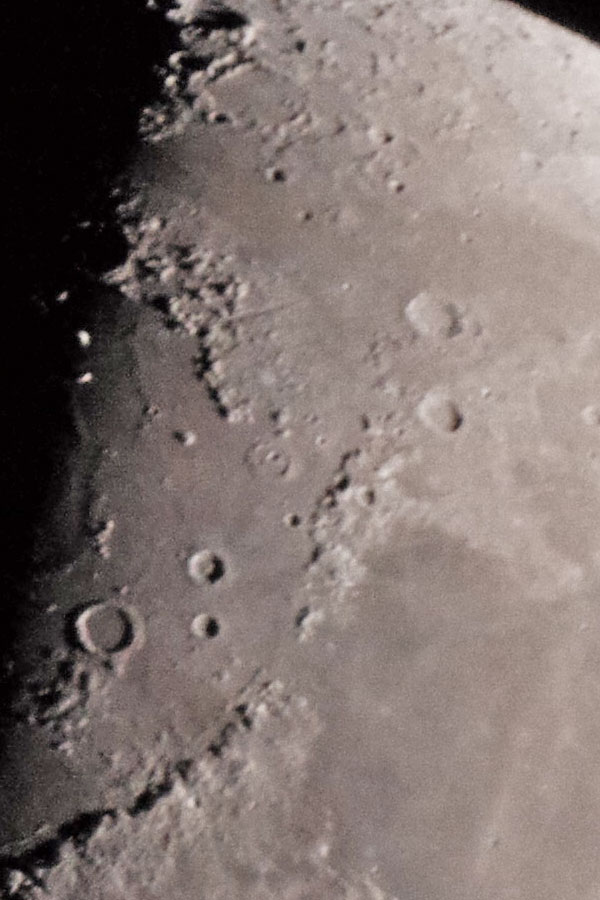 |
|||
Northern section from photo above |
|
Northern section from the photo above |
||
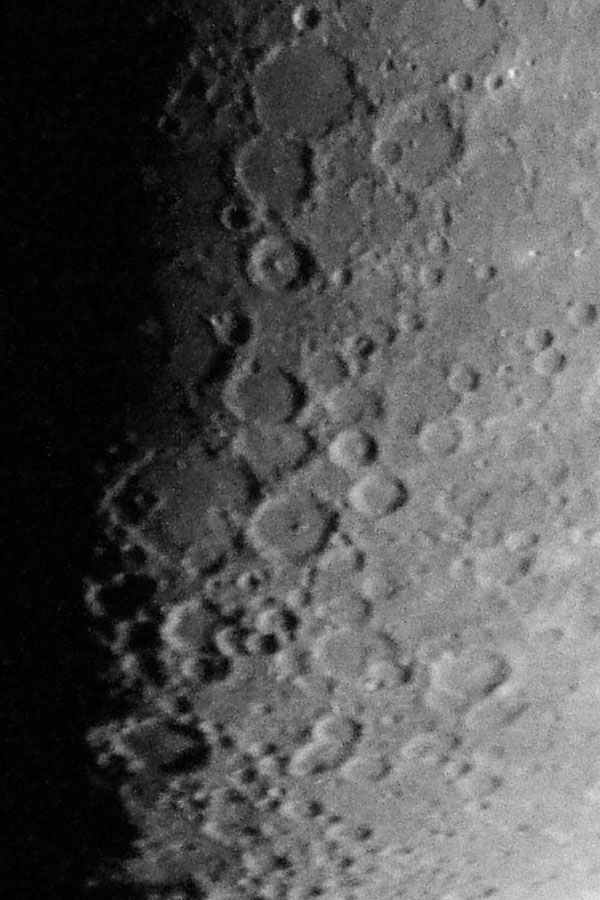 |
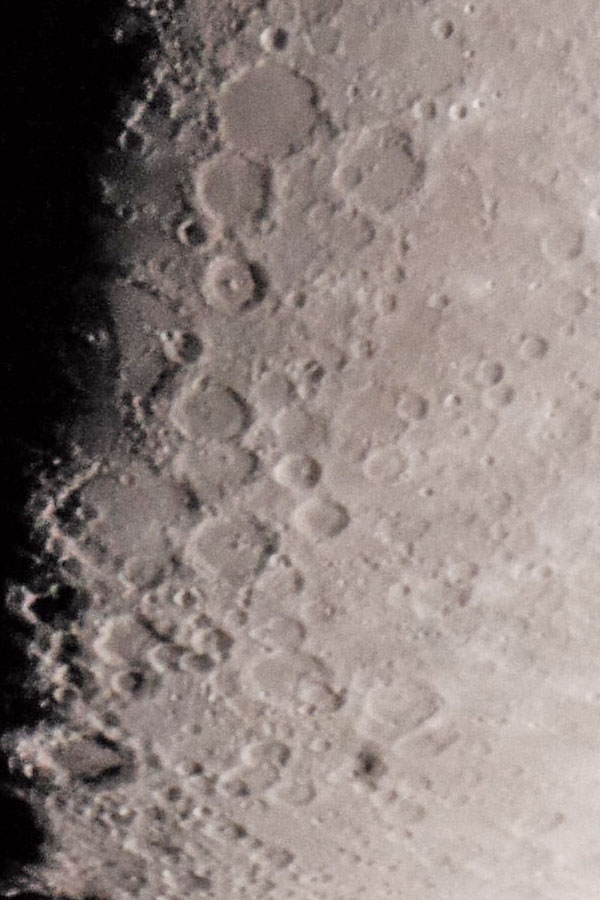 |
|||
|
Southern section from the photo above |
Southern section from the photo above (double contours because of camera shake) |
Photos with Atik Infinity
Photos taken with Skymax-127 and 2 x focal reducer plus extension tube (results in about 3 x reduction) on Star Discovery AZ GoTo mount (Jan 14, 2018):
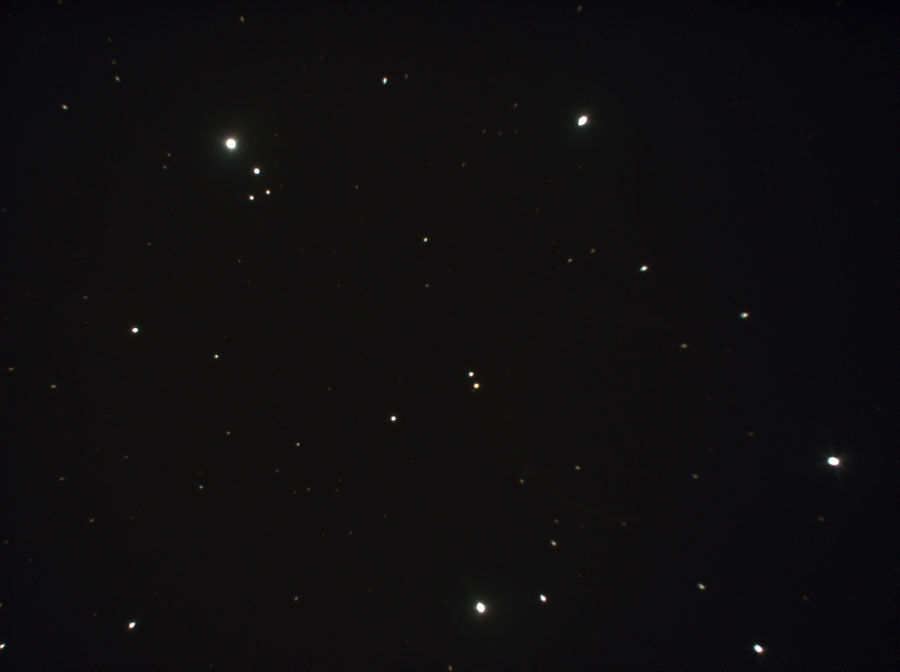 |
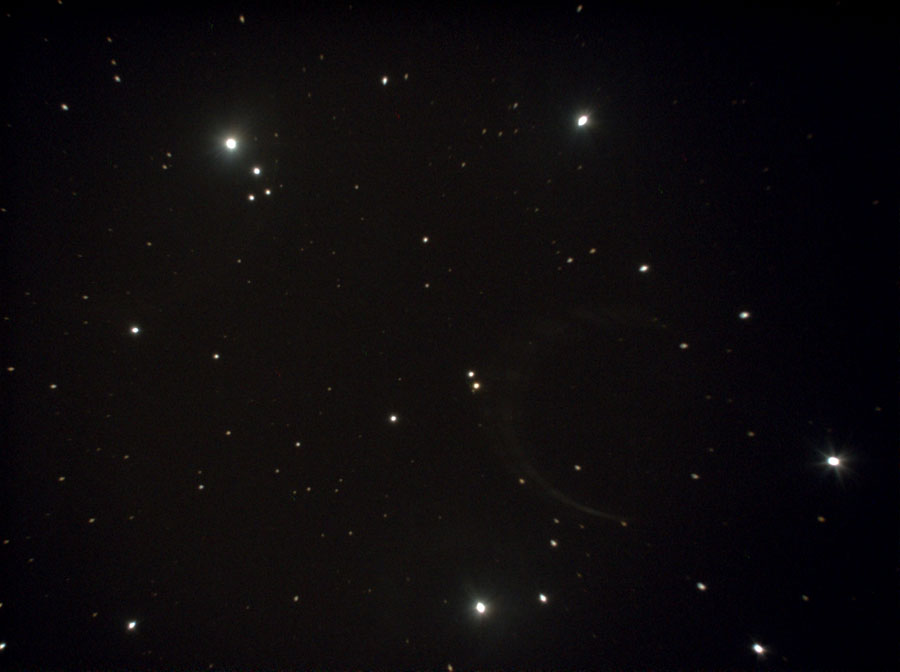 |
|
M 45 (Taurus), center, unprocessed |
M 45 (Taurus), center, post-processed |
|
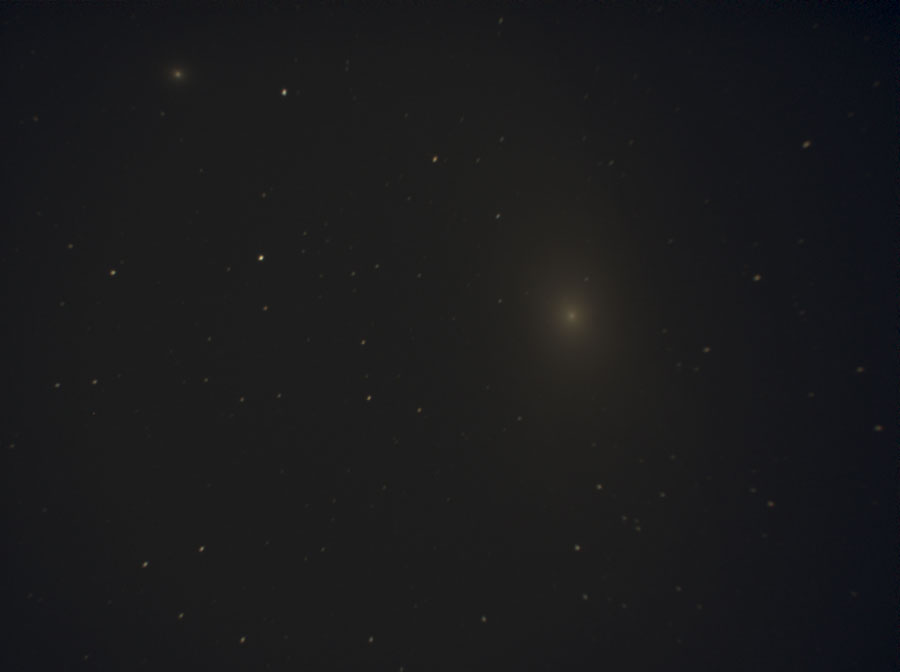 |
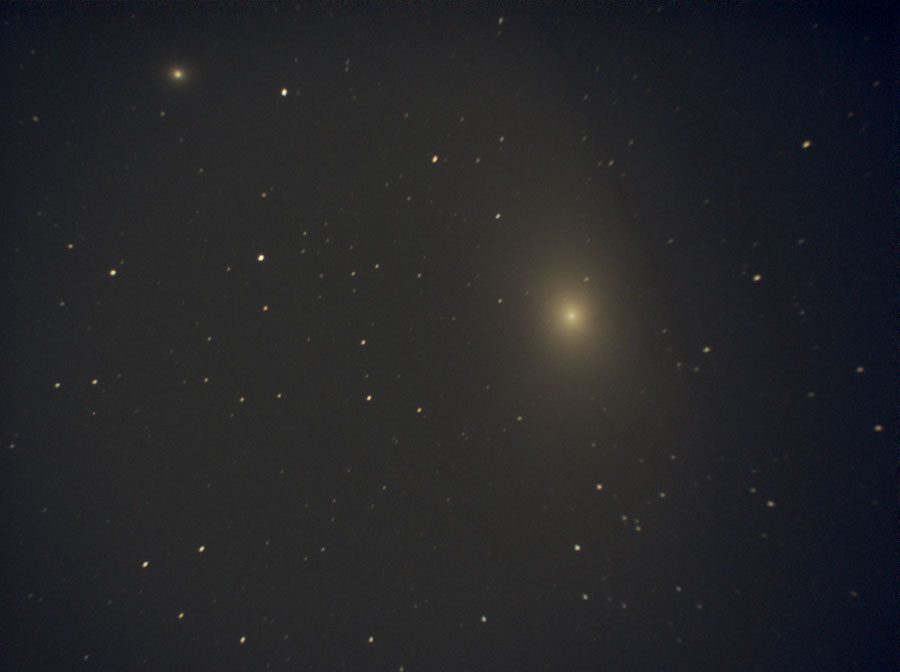 |
|
M 31 and M 32 (top left, Andromeda), unprocessed |
M 31 and M 32 (top left, Andromeda), post-processed |
The following photos were created later from recordings:
Note that these photos show the complete image and that the large versions are in original size. This is due to the fact that the sky objects are extended - even beyond the field of view.
Dry Run with Atik Infinity
In a dry run (18.12.2020), I tested whether the Atik Infinity can be operated at the Skymax-127 without any reducers. This was indeed the case as the following photos show:
|
Skymax-127 with Atik Infinity |
Ditto |
|
|
Result |
|
Preliminary Conclusions
OTA (Comparison with Skymax-102)
First attempts by day and at the moon as well as comparisons with the Sky-Watcher Skymax-102 showed a similar performance for both tubes, with the Sky-Watcher Skymax-127 image appearing slightly brighter and more contrasty. My Astro dealer told me that the Skymax-102 shows the nicer image, but I was not yet able to confirm this.
It should also be noted that, in these comparisons, I cannot use identical magnifications or identical eyepieces. Also, the diagonal mirror of the Skymax-127 is of better quality (a Lacerta model with 99% reflectivity instead of 91%) because the previous owner added a better one. He built an angle finder from the Sky-Watcher diagonal mirror, which I have not used so far.
I also compared both tubes using M 42, the Orion Nebula, on January 14, 2018. Both tubes showed the nebula nicely and dissolved the trapezium well, but I think that I was able to see the "wings" (see the B&W photo below) a little bit better in the Skymax-127.
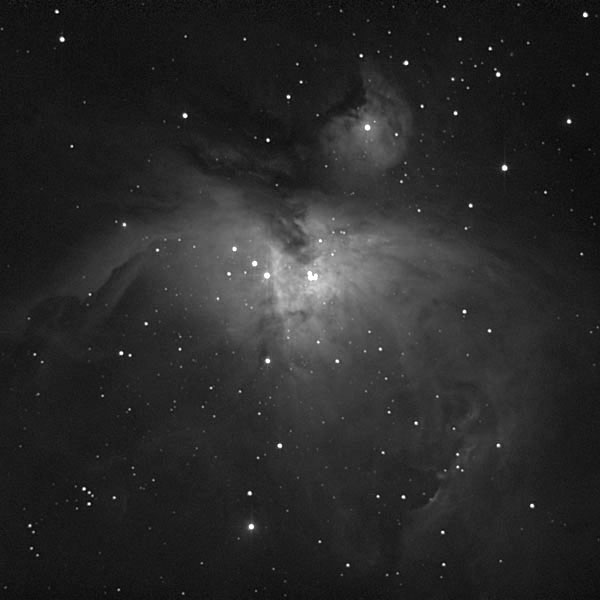
Photo: Photo of M 42/43 with Atik Infinity (B&W version) with Explorer 150PDS
On February 6, 2018 I repeated this test because my astronomy dealer wrote me that you could see differences between the two tubes using the Trapezium in M 42. I had not found any noticeable differences in that respect, and so I wanted to investigate this once more. Again, I was not able to find any noticlable differences in the visual impression of the Trapezium, but in the Skymax-127 the nebula itself seemed to be a little more differentiated than in the Skymax-102. Then I visited the open star cluster M 35 for another comparison and found that it seemed to be more contrasty in the Skymax-127 than in the Skymax-102. But the longer I looked at the object, the less I was able to see differences between the two tubes. All in all, however, I had the impression that the image was somewhat more contrasty and the stars were a little brighter in the Skymax-127 than in the Skymax-102. I also managed focusing better with the Skymax-127 than with the Skymax-102.
At the end of February 2018, I photographed the moon with both Skymax tubes in different configurations. Apart from the problems of camera shake when the Leica M (type 240) was fixed to the telescope or eyepiece, the few sharp results were fine and comparable, although I got the impression that the Skymax-127 has a slight edge, particularly, since it produces a somewhat larger image due to the longer focal length. The latter was fine for my 32 mm eyepiece, to which I can attach a camera with a T-mount adapter.
At the beginning of August 2018, I took photos of Saturn using both telescopes and a Sony RX100 M4. The photos taken with the Skymax-127 showed Saturn a little bit larger and with less color fringes.
All in all, I think that the Skymax-127 has a slight advantage over the Skymax-102 for deep sky objects. I do not know whether that is reason enough to exchange the Skymax-102 for a Skymax-127, as many have done and I as well... In any case, the Skymax-102 is easier to handle thanks to its smaller size and lighter weight. But both tubes still fit in the Sky-Watcher bag, which belongs to the 102-tube and which I bought for my used 127 tube later. With accessories, the tubes weigh 4.3 kg and 2.8 kg (but our balance is not accurate...).
|
Skymax-127 in bag, accessories in front compartment |
Skymax-102 in bag, accessories can lie on tube |
Both tubes in their bags with accessories |
Bases
I used and use the Skymax-127 OTA provisionally on the Heritage 100P base, though that is a bit wobbly (and shaky). The Heritage P130 base or the one from the Orion N 114/450 StarBlast 4.5 are probably suitable, but can regrettably not be purchased without a tube. Perhaps it may be possible to purchase a used base...
Because the lack of a suitable base, I used the Skymax-127 only rarely. In August 2018 I therefore finally bought a Sky-Watcher AZ Pronto mount, which can only carry 3 kg, but it seems to work so far. Except for its load capacity, this mount seems to be ideal for the Skymax-127 tube (the viewfinder sits correctly) and makes fun. And the AZ Pronto mount can, of course, carry the Skymax-102 tube without any weight hassles...
I also use the Skymax-127 OTA on the Star Discovery AZ GoTo mount, on the AZ-GTi AZ GoTo Mount, and maybe on a tripod for day (terrestrial) observations. Using this tube on a tripod is somewhat risky, I think, because of the fairly high tube weight.
Last Words
In December 2020, I purchased a Celestron C5 as a travel and fast to setup telescope. Since both tubes were very similar and because I am not a telescope collector, I decided to part with my Skymax-127 and sold it (January 30, 2021). At the end of October 2021, however, I bought my Skymax-127 back in order to use it in our vacation apartment in Northern Germany. I finally sold at the end of October 2024.
Links
- Sky-Watcher Company Website, USA: skywatcher.com
- Product page: skywatcher.com/product/bk-mak127sp-125/
- Pages from German distributors for the Sky-Watcher Skymax-127 OTA:
- Teleskop-Spezialisten: www.teleskop-spezialisten.de/shop/Teleskope/Maksutov-Cassegrain-MAK/100-145mm/Skywatcher-Skymax-127-OTA-127mm-1500mm-Maksutov-Teleskop::312.html (in German) - www.teleskop-spezialisten.de/shop//Maksutov-Cassegrain/100-145mm/::312.html?language=en (in English)
- Teleskop-Service/Express (here the telescope was bought): www.teleskop-express.de/shop/product_info.php/info/p2771_Skywatcher-Skymax-127-OTA---127-1500mm-Maksutov-Teleskop.html (in German) - www.teleskop-express.de/shop/product_info.php/language/en/info/p2771_Skywatcher-Skymax-127-OTA---127-1500mm-Maksutov-Teleskop.html (in English)
- Astroshop: www.astroshop.de/skywatcher-maksutov-teleskop-mc-127-1500-skymax-bd-ota/p,14981 (in German) - www.astroshop.eu/skywatcher-maksutov-telescope-mc-127-1500-skymax-bd-ota/p,14981 (in English)
- See also my page offering Astronomy Links.
Appendix Data for Sky-Watcher Skymax-127 OTA
Technical Data
| Telescope: Sky-Watcher | Skymax-127 |
| Optical Design | Maksutov-Cassegrain |
| Primary Mirror Diameter | 127 mm (5") |
| Focal Length, Focal Ratio | 1500 mm, f/11.8 |
| Resolving Power (arc secs) | 0.91" |
| Limiting Visual Stellar Magnitude | 13.2 mag |
| Light Gathering Power | 329.2 |
| Maximum Practical Visual Power | 254 x |
| Optical Tube Dimensions (diam. x length) | 14.4 x 33 cm |
| Net Weight Basis | --- |
| Net Weight Optical Tube | 3.4 kg |
| Net Weight Complete | --- |
Dark Blue: Telescopes that I still own; italic and dark red: telescopes that I owned; black: for comparison; *) own measurement; **) corrected values
See also the table of basic data for all of my telescopes (and a few more...)
Observation-Relevant Data (in Comparison with other Cassegrain Tubes)
| Telescope | Focal |
Aperture (mm) |
Focal Ratio |
Light Gathering Power |
Maximum+ |
Minimum* |
Maximum* |
Minimum+ |
|||||
Usable Magnification |
Usable Focal
Length of Eyepiece (mm) |
||||||||||||
Factor/Exit Pupil (mm) > |
Manuf. |
1.5 |
2 |
6.5 |
7 |
6.5 |
7 |
1.5 |
2 |
||||
| ETX 90/EC (Maksutov-Cassegrain) | 1250 |
90 |
13.89 |
165 |
325 |
135 |
180 |
13.84 |
12.85 |
90.4 |
97.3 |
9.3 |
6.9 |
| Skymax-102 (Maksutov-Cassegrain) | 1300 |
102 |
12.75 |
212 |
153 |
204 |
15.69 |
14.57 |
82.9 |
89.3 |
8.5 |
6.4 |
|
| Skymax-127 (Maksutov-Cassegrain) | 1500 |
127 |
11.81 |
329 |
191 |
254 |
19.54 |
18.14 |
76.8 |
82.7 |
7.9 |
5.9 |
|
| Celestron C5 (Schmidt-Cassegrain) | 1250 |
125 |
10 |
319 |
295/300 |
188 |
250 |
19.23 | 17.86 | 65.0 |
70.0 |
6.7 |
5.0 |
| Cel. C5 (Schmidt-Cassegrain) (Red.) | 787.5 |
125 |
6.3 |
319 |
295/300 |
188 |
250 |
19.23 | 17.86 | 41.0 |
44.1 |
4.2 |
3.2 |
| Celestron C8 (Schmidt-Cassegrain) | 2032 |
203 |
10 |
841 |
305 |
406 |
31.26 |
29.03 |
65.0 |
70.0 |
6.7 |
5.0 |
|
| Cel. C8 (Schmidt-Cassegrain) (Red.) | 1280 |
203 |
6.3 |
841 |
305 |
406 |
31.26 |
29.03 |
41.0 |
44.1 |
4.2 |
3.2 |
|
*) Calculated for an exit pupil of 6.5 mm and 7 mm
+) Factor 1.5 or 2 for Dobsonian/Newtonian telescopes; in general, the lower
value of 1.5 is used for Newtonian telescopes; if the manufacturer specified
a different magnification, it is also listed (some manufacturer provide considerably
higher numbers...).
Visual Power (Magnification) and Other Data for Different Focal Lengths of Eyepieces (Mostly My Current Eyepieces)
Note: These tables include the StarTravel 120 refractor, a TSWA32 eyepiece (2", 32 mm focal length, 70° viewing angle) that I borrowed together with the StarTravel 120, a 18 mm eyepiece (2", 82° viewing angle), a 38 mm eyepiece (2", 70° viewing angle), and a 56 mm eyepiece (2", 52° viewing angle).
| Telescope | Further Data |
Focal Length of Eyepiece (mm) |
||||||||||||
| Magnification | ||||||||||||||
Focal Length of Telescope (mm) |
4 |
7 |
10 |
16 |
18 |
24 |
26 |
32 |
32 |
35 |
38 |
40 |
56 |
|
| PS 72/432 | 432 |
108.00 |
61.71 |
43.20 |
27.00 |
24.00 |
18.00 |
16.62 |
13.50 |
13.50 |
12.34 |
11.37 |
10.80 |
7.71 |
| ST120 | 600 |
150.00 |
85.71 |
60.00 |
37.50 |
33.33 |
25.00 |
23.08 |
18.75 |
18.75 |
17.14 |
15.79 |
15.00 |
10.71 |
| TLAPO1027 | 714 |
178.50 |
102.00 |
71.40 |
44.63 |
39.67 |
29.75 |
27.46 |
22.31 |
22.31 |
20.40 |
18.79 |
17.85 |
12.75 |
| 150PDS | 750 |
187.50 |
107.14 |
75.00 |
46.88 |
41.67 |
31.25 |
28.85 |
23.44 |
23.44 |
21.43 |
19.74 |
18.75 |
13.39 |
| SM127 | 1500 |
375.00 |
214.29 |
150.00 |
93.75 |
--- |
62.50 |
57.69 |
46.88 |
--- |
42.86 |
--- |
37.50 |
--- |
| SM127 (Red.) | 945 |
236.25 |
135.00 |
94.50 |
59.06 |
--- |
39.38 |
36.35 |
29.53 |
--- |
27.00 |
--- |
23.63 |
--- |
| SM102 | 1300 |
325.00 |
185.71 |
130.00 |
81.25 |
--- |
54.17 |
--- |
40.63 |
--- |
--- |
--- |
--- |
--- |
| C5 | 1250 |
312.50 |
178.57 |
125.00 |
78.13 |
69.44 |
52.08 |
48.08 |
39.06 |
39.06 |
35.71 |
32.89 |
31.25 |
22.32 |
| C5 (Red.) | 787.5 |
196.88 |
112.50 |
78.75 |
49.22 |
--- |
32.81 |
30.29 |
24.61 |
--- |
22.50 |
--- |
19.69 |
--- |
| C8 | 2032 |
508.00 |
290.29 |
203.20 |
127.00 |
112.89 |
84.67 |
78.15 |
63.50 |
63.50 |
58.06 |
53.47 |
50.80 |
36.29 |
| C8 (Red.) | 1280 |
320.00 |
182.86 |
128.00 |
80.00 |
--- |
53.33 |
49.23 |
40.00 |
--- |
36.57 |
--- |
32.00 |
--- |
| True Field of View (°) | ||||||||||||||
Apparent Field of View (°) > |
82 |
82 |
72 |
82 |
82 |
65 |
70 |
52 |
70 |
69 |
70 |
68 |
52 |
|
Focal Length of Telescope (mm) |
4 |
7 |
10 |
16 |
18 |
24 |
26 |
32 |
32 |
35 |
38 |
40 |
56 |
|
| PS 72/432 | 432 |
0.76 |
1.33 |
1.67 |
3.04 |
3.42 |
3.61 |
4.21 |
3.85 |
5.19 |
5.59 |
6.16 |
6.30 |
6.74 |
| ST120 | 600 |
0.55 |
0.96 |
1.20 |
2.19 |
2.46 |
2.60 |
3.03 |
2.77 |
3.73 |
4.03 |
4.43 |
4.53 |
4.85 |
| TLAPO1027 | 714 |
0.46 |
0.80 |
0.91 |
1.84 |
2.07 |
2.18 |
2.55 |
2.33 |
3.14 |
3.38 |
3.73 |
3.92 |
4.08 |
| 150PDS | 750 |
0.44 |
0.77 |
0.96 |
1.75 |
1.97 |
2.08 |
2.43 |
2.22 |
2.99 |
3.22 |
3.55 |
3.63 |
3.88 |
| SM127 | 1500 |
0.22 |
0.38 |
0.48 |
0.87 |
--- |
1.04 |
1.21 |
1.11 |
--- |
1.61 |
--- |
1.81 |
--- |
| SM127 (Red.) | 945 |
0.35 |
0.61 |
0.76 |
1.39 |
--- |
1.65 |
1.93 |
1.76 |
--- |
2.56 |
--- |
2.88 |
--- |
| SM102 | 1300 |
0.25 |
0.44 |
0.55 |
1.01 |
--- |
1.20 |
--- |
1.28 |
--- |
--- |
--- |
--- |
--- |
| C5 | 1250 |
0.26 |
0.46 |
0.58 |
1.05 |
1.18 |
1.25 |
1.46 |
1.33 |
1.79 |
1.93 |
2.13 |
2.18 |
2.33 |
| C5 (Red.) | 787.5 |
0.42 |
0.73 |
0.91 |
1.67 |
--- |
1.98 |
2.31 |
2.11 |
--- |
3.07 |
--- |
3.45 |
--- |
| C8 | 2032 |
0.16 |
0.28 |
0.35 |
0.65 |
0.73 |
0.77 |
0.90 |
0.82 |
1.10 |
1.19 |
1.31 |
1.34 |
1.43 |
| C8 (Red.) | 1280 |
0.26 |
0.45 |
0.63 |
1.03 |
--- |
1.22 |
1.42 |
1.30 |
--- |
1.89 |
--- |
2.13 |
--- |
| Exit Pupil (mm) | ||||||||||||||
Focal Ratio |
4 |
7 |
10 |
16 |
18 |
24 |
26 |
32 |
32 |
35 |
38 |
40 |
56 |
|
| PS 72/432 | 6 |
0.67 |
1.17 |
1.67 |
2.67 |
3.00 |
4.00 |
4.33 |
5.33 |
5.33 |
5.83 |
6.33 |
6.67 |
9.33 |
| ST120 | 5 |
0.80 |
1.40 |
2.00 |
3.20 |
3.60 |
4.80 |
5.20 |
6.40 |
6.40 |
7.00 |
7.60 |
8.00 |
11.20 |
| TLAPO1027 | 7 |
0.57 |
1.00 |
1.43 |
2.29 |
2.57 |
3.43 |
3.71 |
4.57 |
4.57 |
5.00 |
5.43 |
5.71 |
8.00 |
| 150PDS | 5 |
0.80 |
1.40 |
2.00 |
3.20 |
3.60 |
4.80 |
5.20 |
6.40 |
6.40 |
7.00 |
7.60 |
8.00 |
11.20 |
| SM127 | 11.81 |
0.34 |
0.59 |
0.85 |
1.35 |
--- |
2.03 |
2.20 |
2.71 |
--- |
2.96 |
--- |
3.39 |
--- |
| SM127 (Red.) | 7.44 |
0.54 |
0.94 |
1.34 |
2.15 |
--- |
3.23 |
3.49 |
4.30 |
--- |
4.70 |
--- |
5.38 |
--- |
| SM102 | 12.75 |
0.31 |
0.55 |
0.78 |
1.26 |
--- |
1.88 |
--- |
2.51 |
--- |
--- |
--- |
--- |
--- |
| C5 | 10 |
0.40 |
0.70 |
1.00 |
1.60 |
1.80 |
2.40 |
2.60 |
3.20 |
3.20 |
3.50 |
3.80 |
4.00 |
5.60 |
| C5 (Red.) | 6.3 |
0.63 |
1.11 |
1.59 |
2.54 |
--- |
3.81 |
4.13 |
5.08 |
--- |
5.56 |
--- |
6.35 |
--- |
| C8 | 10 |
0.40 |
0.70 |
1.00 |
1.60 |
1.80 |
2.40 |
2.60 |
3.20 |
3.20 |
3.50 |
3.80 |
4.00 |
5.60 |
| C8 (Red.) | 6.3 |
0.63 |
1.11 |
1.59 |
2.54 |
--- |
3.81 |
4.13 |
5.08 |
--- |
5.56 |
--- |
6.35 |
--- |
Blue: Equipment borrowed for comparison purposes; gray: sold equipment; italic: 2" eyepieces
Magnification: Yellow: low (30-50 x); magenta: medium
(80-100 x); violet: high (150-200 x - and more); red: beyond
maximum usable magnification.
Exit pupil: Values in magenta cells are
either too small (< 1 mm) or too large (> 6.4/7 mm); yellow background:
best for galaxies (about 2-3 mm).
Recommendations for the Focal Lengths of Eyepieces for Skymax-127 (Following My Recommendations and Those of Others)
| Criteria | Exit Pupil |
Focal
Length of Eyepiece |
|||||
| Category | Application Area | from...to |
Calculated |
On the Market |
Examples |
Existing |
|
| Maximum FOV | Search | 7 |
10 |
83-118 |
---** |
--- |
--- |
| Minimum Magnification / Large FOV | Overview, large-area nebulae | 4.5 |
6.5 |
53-77 |
---** |
--- |
--- |
| Normal Magnification | Large-area, faint nebulae; nebulae, open star clusters | 3.5 |
4 |
41-47 |
40** |
40** |
--- |
| Best for many objects, e.g. for most galaxies, and mid-size DSO | 2 |
3 |
24-36 |
24-40 |
24, 25, 32 |
24, 32 |
|
| Maximum Magnification / Maximum Resolution | "Normal" upper magnification limit; globular star clusters | 1 |
1.5 |
12-18 |
12-18 |
12, 15, 16, 18 |
16 |
| Maximum perceptibility of small, low-contrast
details; planetary nebulae, small galaxies; maximum magnification for moon and planets |
0.6 |
0.8 |
7-9.5 |
7-10 |
7-10 |
7, 10 |
|
| Separation of narrow double stars, small planetary
nebulae; perception of faintest details |
0.4 |
0.5 |
4.7-6 |
4.5-6 |
5...6 |
(4) |
|
*) Partly available as 2" eyepiece; **) typically no suitable 1,25" eyepieces available; problems with viewing at 40 mm; italic: not possible; red: magnification too high; blue: commercial focal lengths
| 21.11.2024 |
